Set, Meet, Own
UCHealth Service Framework
Set, Meet, Own
The UCHealth Service Framework enhances the quality and consistency of patient and staff experiences by addressing common pain points and barriers with every interaction. This approach allows patients and their families to focus on healing rather than navigating complex, service-related interactions. It empowers staff to build trust and partnership in the ever-changing landscape of health care.


Why Set, Meet, Own?
Our patients come to us with some level of fear and anxiety. Our own staff experience fear and anxiety at work. Moments of uncertainty, boredom, isolation and disregard can increase a person’s fear and anxiety. Best practices inside and outside of health care showcase that consistently setting realistic expectations and meeting those expectations allow us all to feel a sense of control and partnership, which can mitigate fear and anxiety.
People carry expectations of their experiences, whether or not they express them or even are aware of them. Often, we aren’t aware of those expectations and are therefore, less likely to meet them. When we clearly set reasonable expectations about another’s experience with us, we are more equipped to meet those expectations and ensure our patients and staff are included in decision-making.
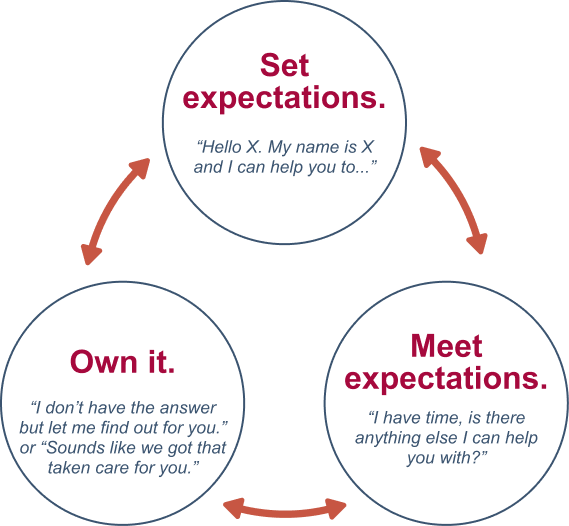
This is the foundational framework to drive an experience-forward culture for our patients and staff.
How
This section provides essential steps for staff and leaders to create a consistent, positive experience in every interaction. Click on each card to view examples.
Consistent / Non-negotiable expectations of all staff
Set Expectations
Introduce yourself, state your role, and explain what is about to happen.
Be kind and transparent.
Meet Expectations
Follow through with the expectations you set. Ask if there is anything else you can help with.
Own Expectations
Close the loop by stating the met expectation. If an expectation can’t be met, explain why, empathize, and discuss potential next steps.
Engagement and Accountability
Tips
#1
Identify common expectations with patients and staff that directly align with your daily work. Discuss how to Set, Meet, and Own these expectations
#2
Leverage your existing patient and staff touch-points (such as rounding and leader rounding) to apply the Set, Meet, Own service framework.
#3
Reach out to your Experience Team for support as needed
Examples
What does success look like when Set, Meet, Own works for our patients?
Explore the thoughts and feelings of our patients when the Set, Meet, Own framework is successfully applied. This example shows how exceptional care can make a difference.
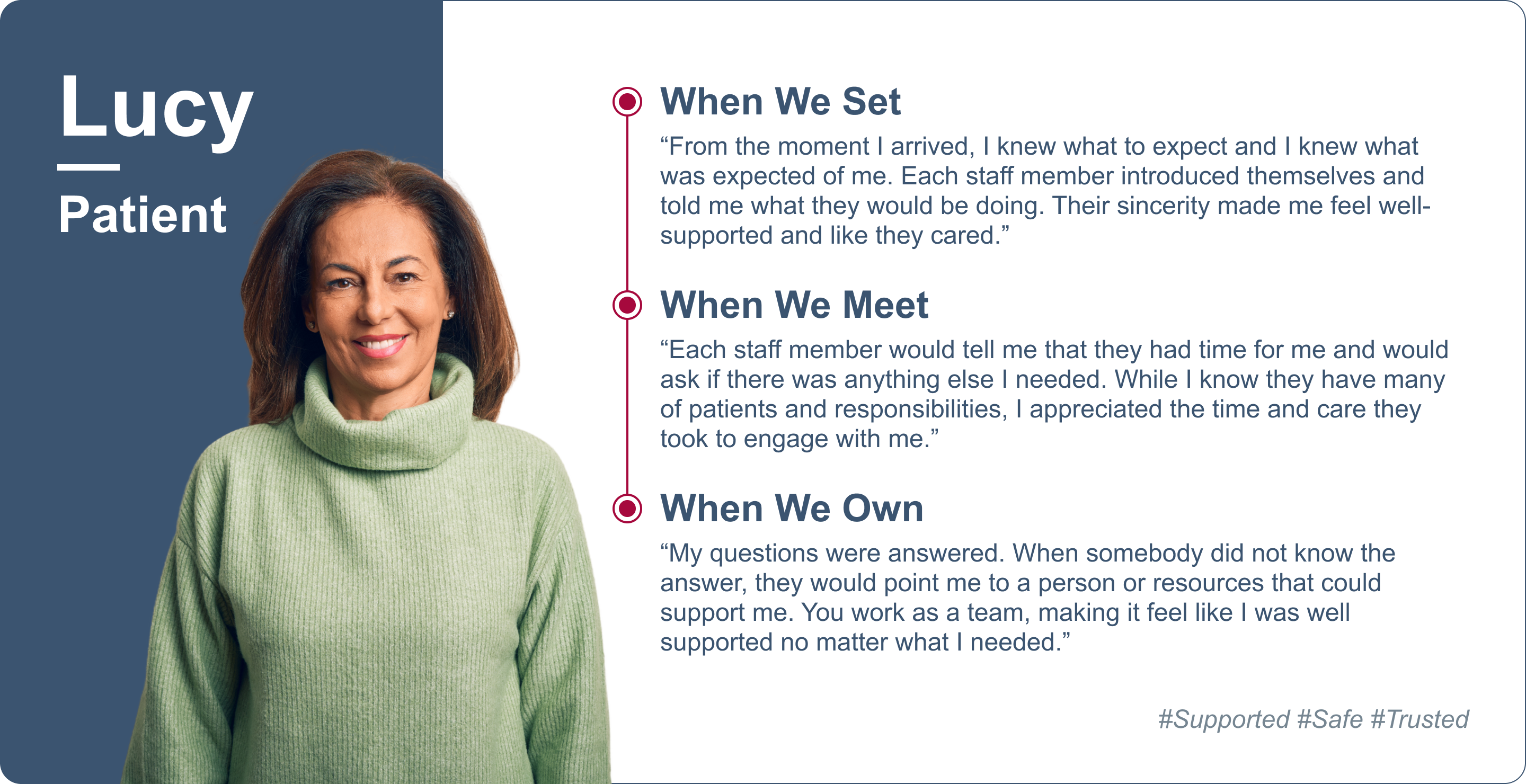
How can you apply Set, Meet, Own in your role?
These personas provide examples for applying Set, Meet, Own framework in different roles at UCHealth. Click on one of these roles to learn how to Set, Meet, Own in your daily work.
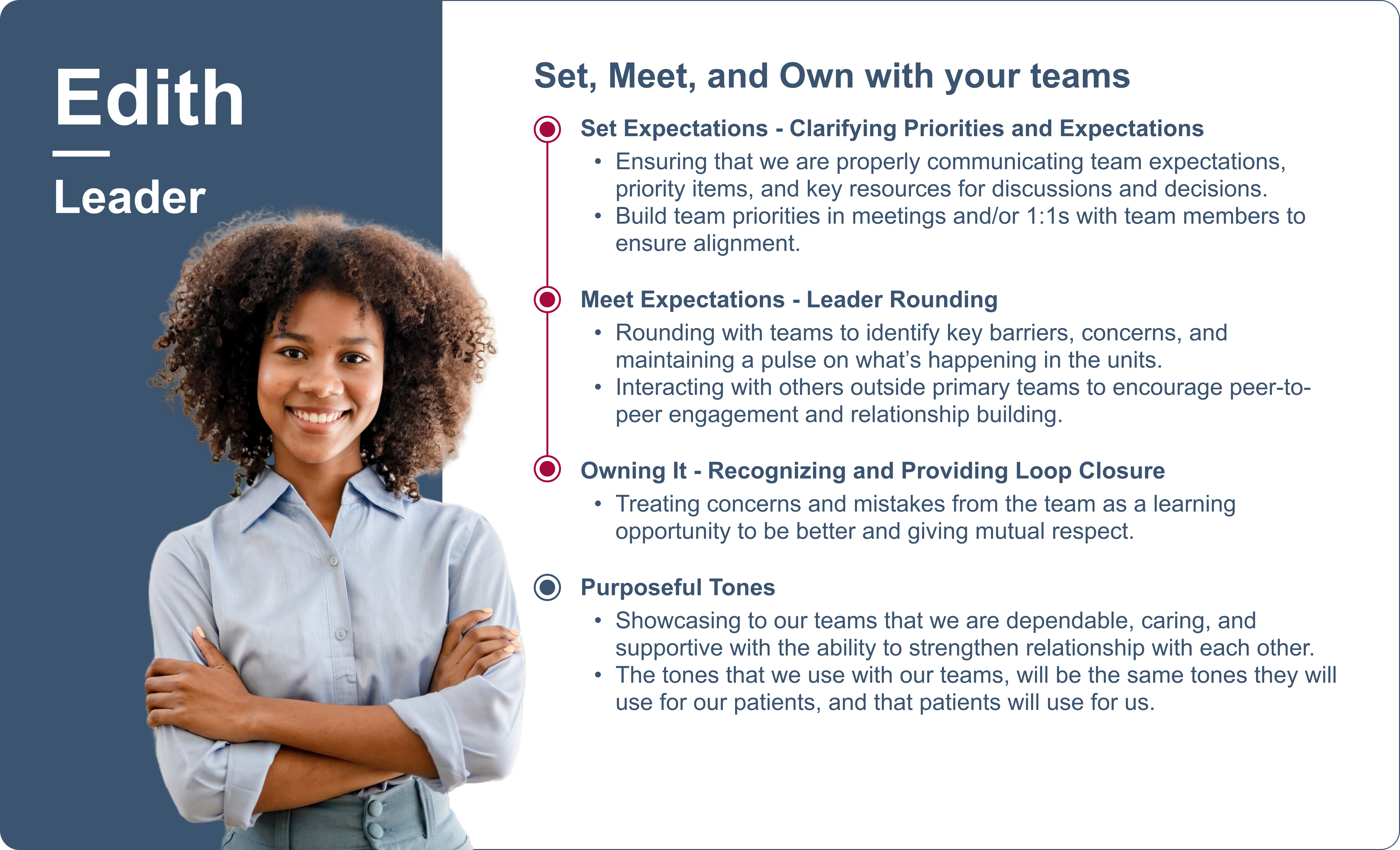
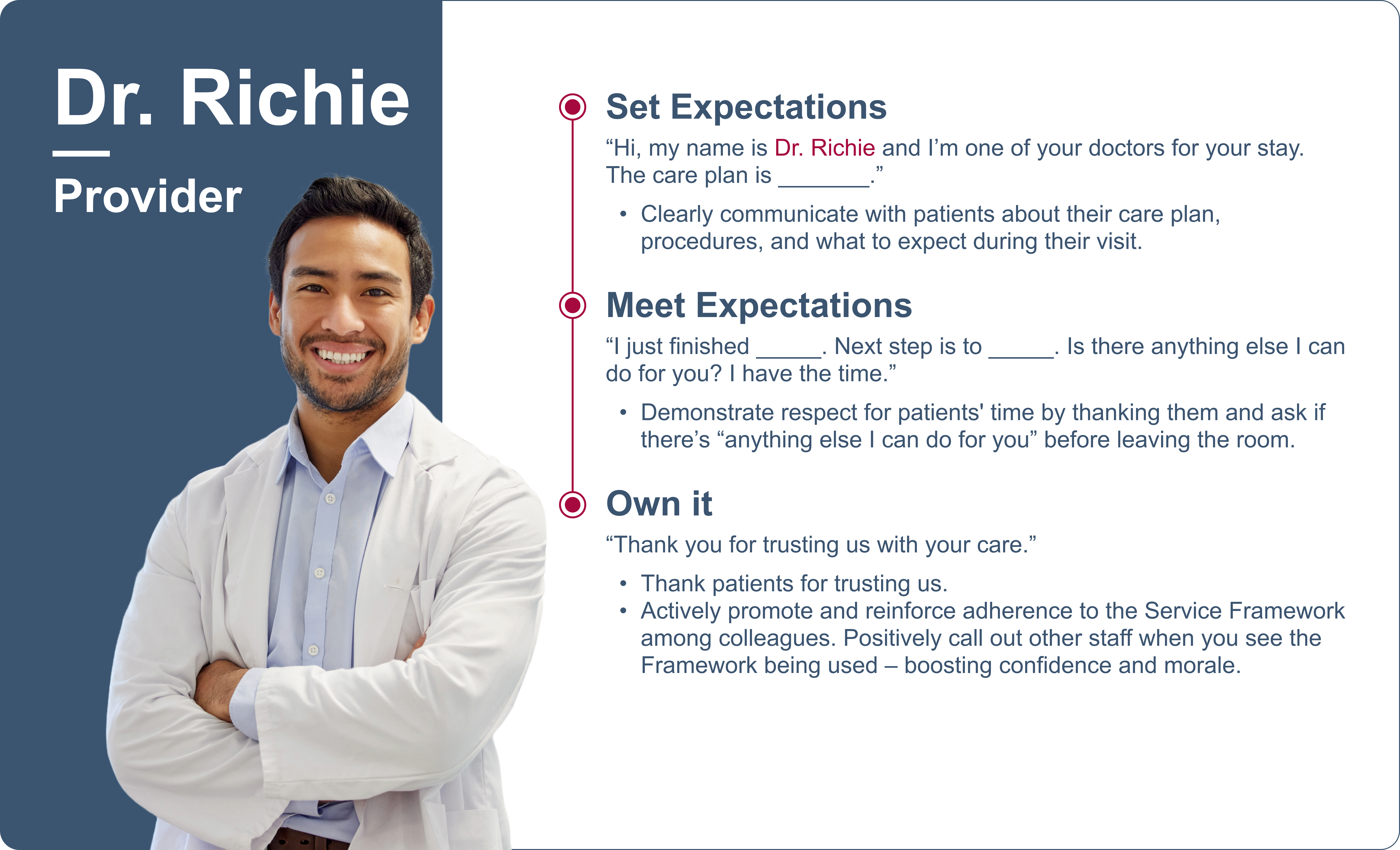
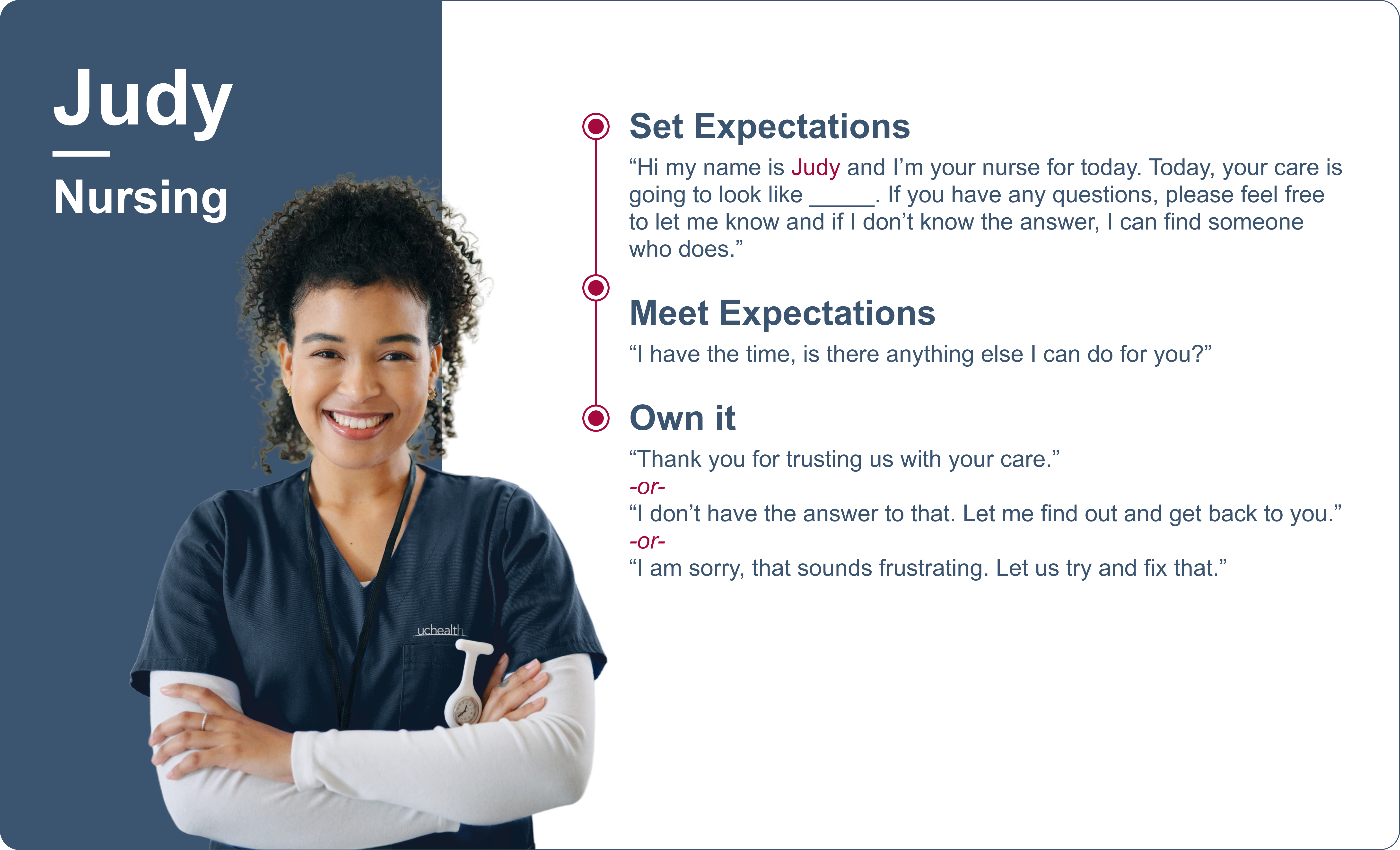
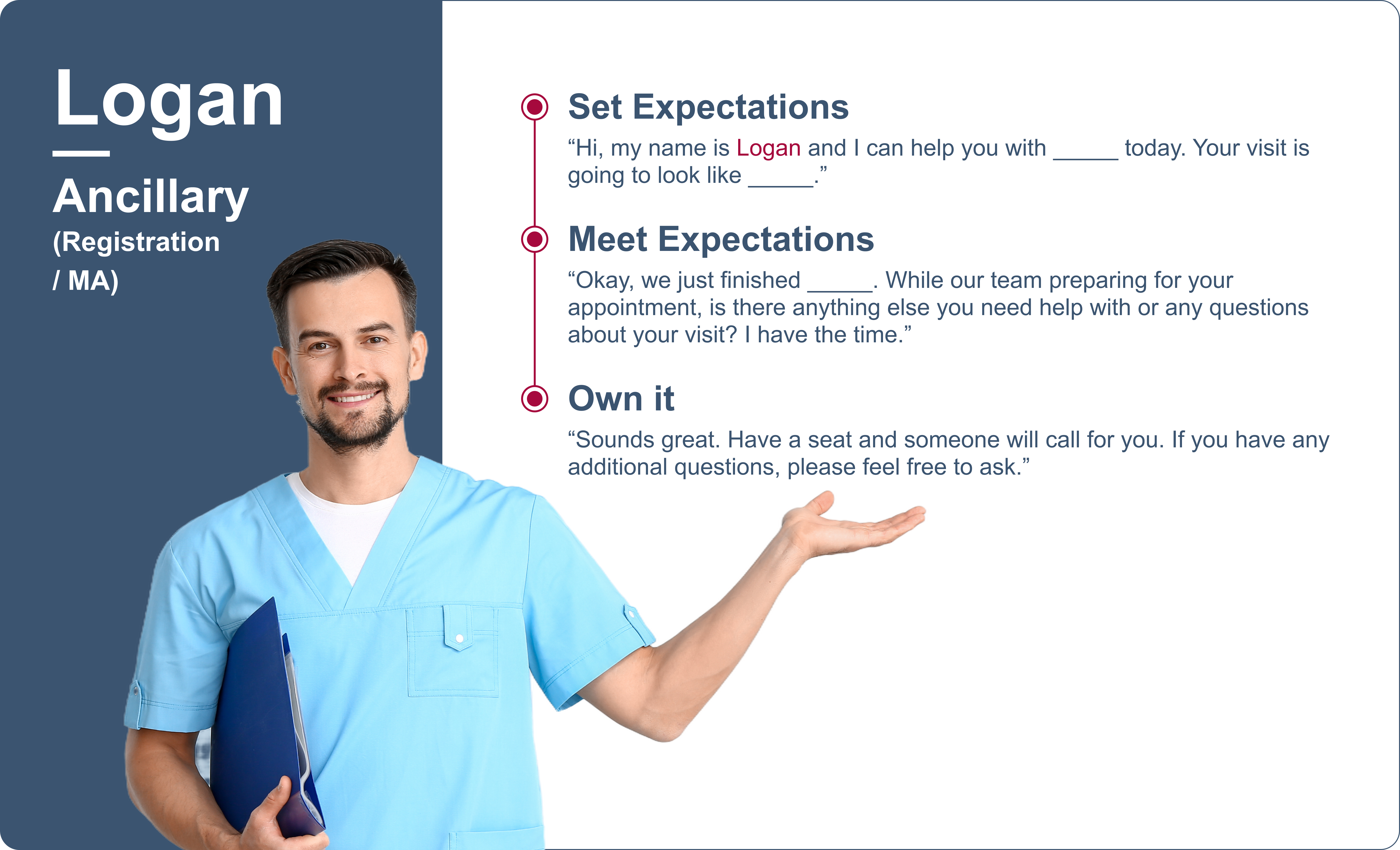
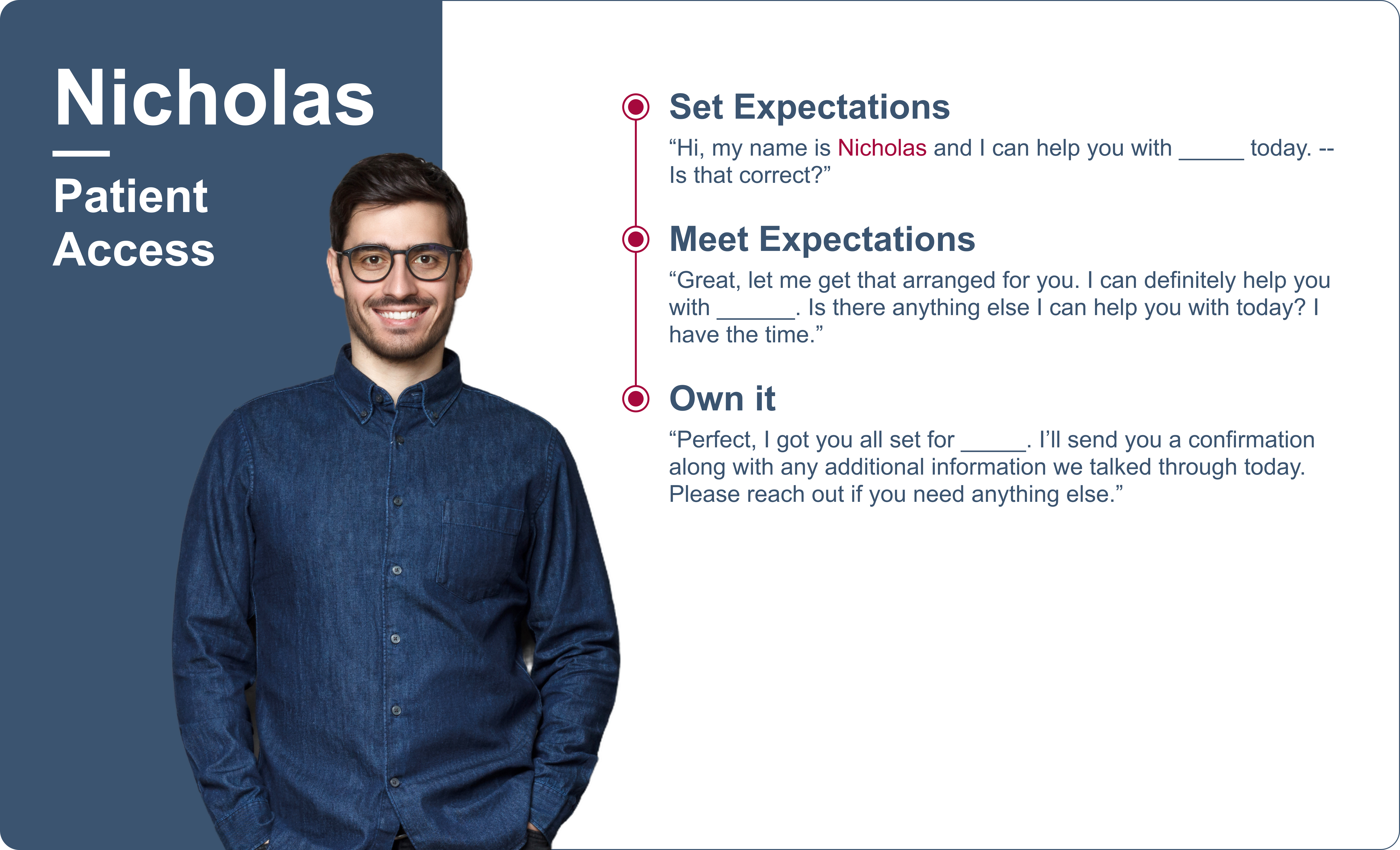
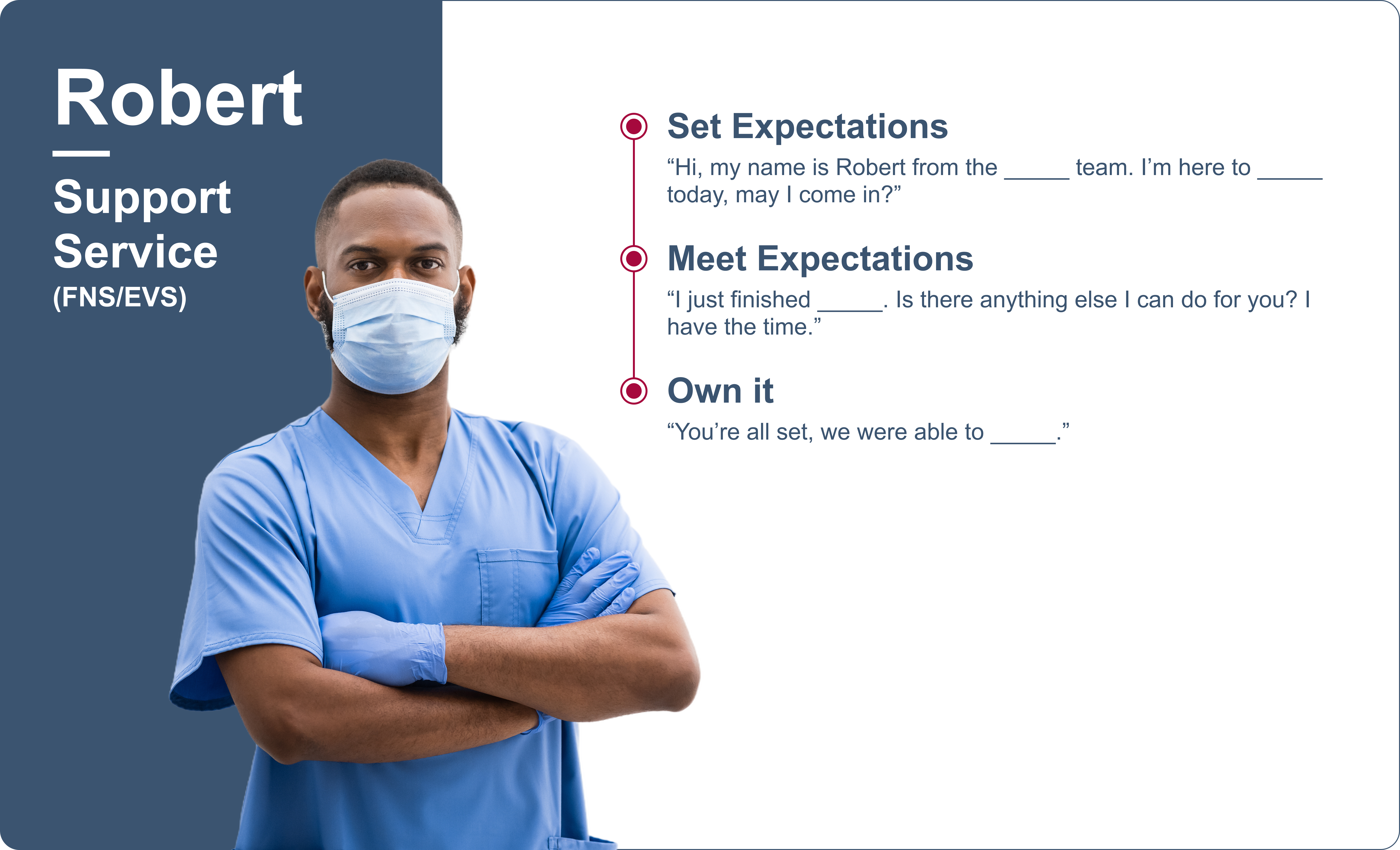
Where can you find all the examples?
Want to see more examples? Head to our SharePoint and download them if you’d like!
Set, Meet, Own
Rounding
Our ability to understand our patients needs and expectations is imperative to delivering quality health care through an extraordinary experience. When we allow space for patients and families to ask questions and share meaningful feedback, we give ourselves the opportunity to meet their expectations and ultimately improve the health outcomes of our communities. Rounding is the most effective way to gain in-the-moment feedback that ensures patients receive care and compassion they deserve.

What does it mean to round?
A patient round is an intentional visit with a patient and/or family member to gain insights about their experience.
In these moments, we are able to:

How
Applying Set, Meet, Own framework into rounding
Set Expectations
Build Connection by being human and ask about their experience.
Start by building rapport through small gestures – introducing yourself and the purpose of your visit.
Meet Expectations
Listen & Validate —
People want to be heard. Hear the message and probe to understand more fully.
Own Expectations
Offer solutions if possible — whether or not we fully understand their perspective, validating another person’s perspective decreases fear and increases trust.
Manage Up Your Team
We have amazing people providing care in a complex dynamic of health care. Speak highly of your colleagues, even if you do not know them well, to build trust.
For example, “John is amazing and I know he’ll have the time to make sure you have all your questions answered. He knows a lot of resources too so if he doesn’t know the answer, I trust he’ll get you connected with what you need.”
End the Interaction
Be clear that the feedback is welcome and thank the person for their time to end the interaction.
For example, “Juan, thank you so much for taking the time to share your experiences with me. I will follow up with you on the questions you had within the next 20 minutes or so. Thank you for trusting us to take care of you.”
Tips
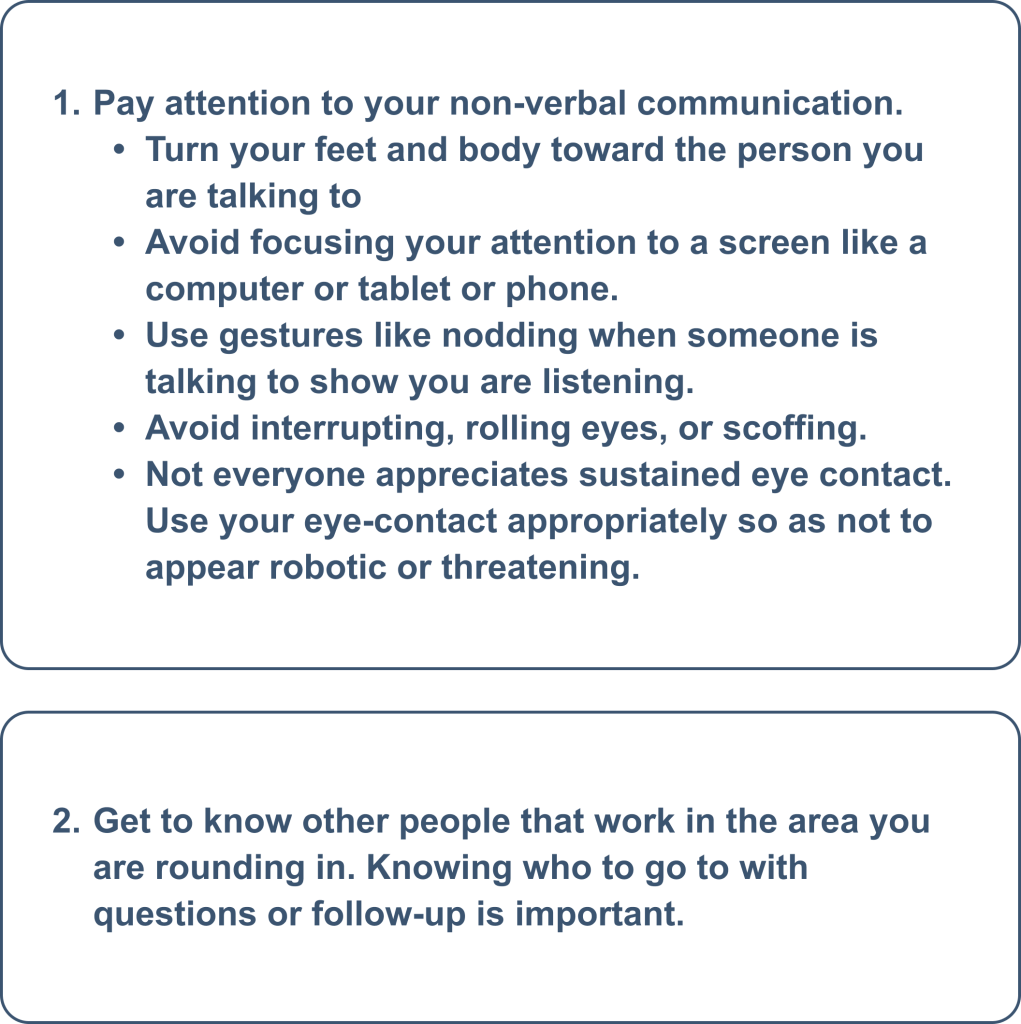
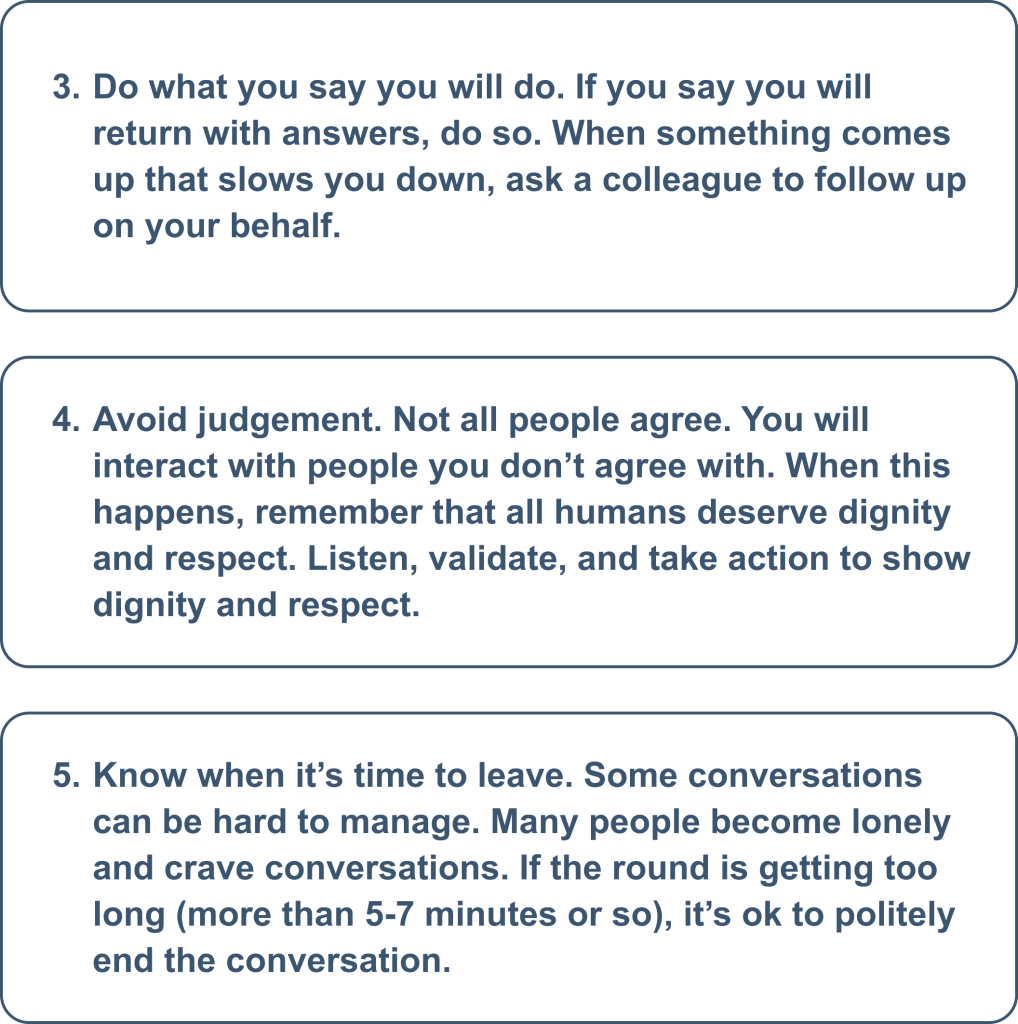
Examples
Resources
1. Customize to units and users
The framework is designed with the idea that it is adaptable to all teams and all levels of interaction. We want to work with you! Reach out to the Experience Team to find out how we can partner to customize this for your team.
2. We’ve got tools to help you
- Jump into the Rounding App and get started!
(You’ll need both a UCHealth email and Epic access to use the Rounding App. If you don’t have either, please submit an ITSM request for access.) - Explore the Support Resources in our SharePoint folder, full of helpful Rounding App docs.
- Check out the Power BI Rounding Report for detailed insights (best viewed on desktop).
Set, Meet, Own
Service Recovery
Our organization is powerful and full of amazing teams and resources, but we aren’t perfect. When it happens, we sometimes become lost and unsure of how to move forward. We embrace any mistakes or failures together, and approach as a unified front to identify and fix any opportunities within our power. This gives us the chance to restore trust, grow confidence, and turn some of our most frustrating experiences into forgiveness and loyalty.
We improve lives and sometimes even with the best of intentions we may fall short. When we do, we have an opportunity to restore a negative situation into a positive statement about UCHealth. Service Recovery is a second chance to regain trust and repair an impacted relationship.

How
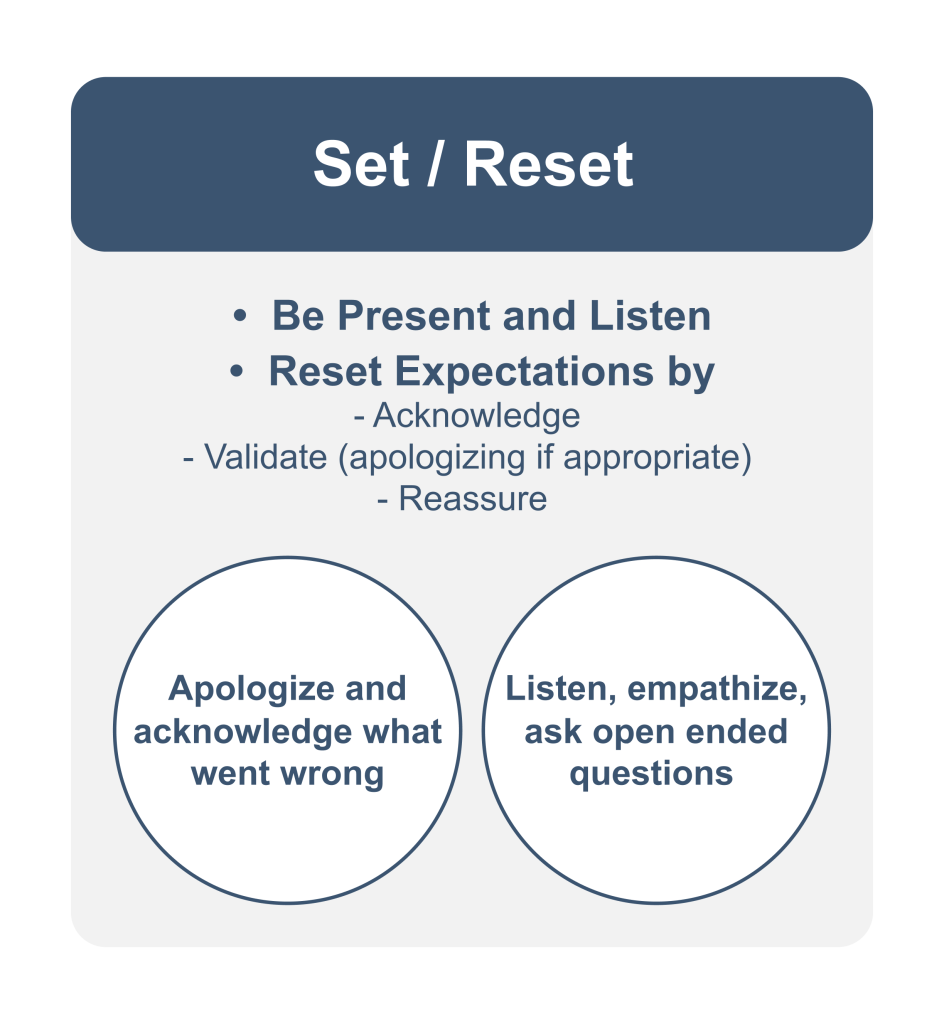
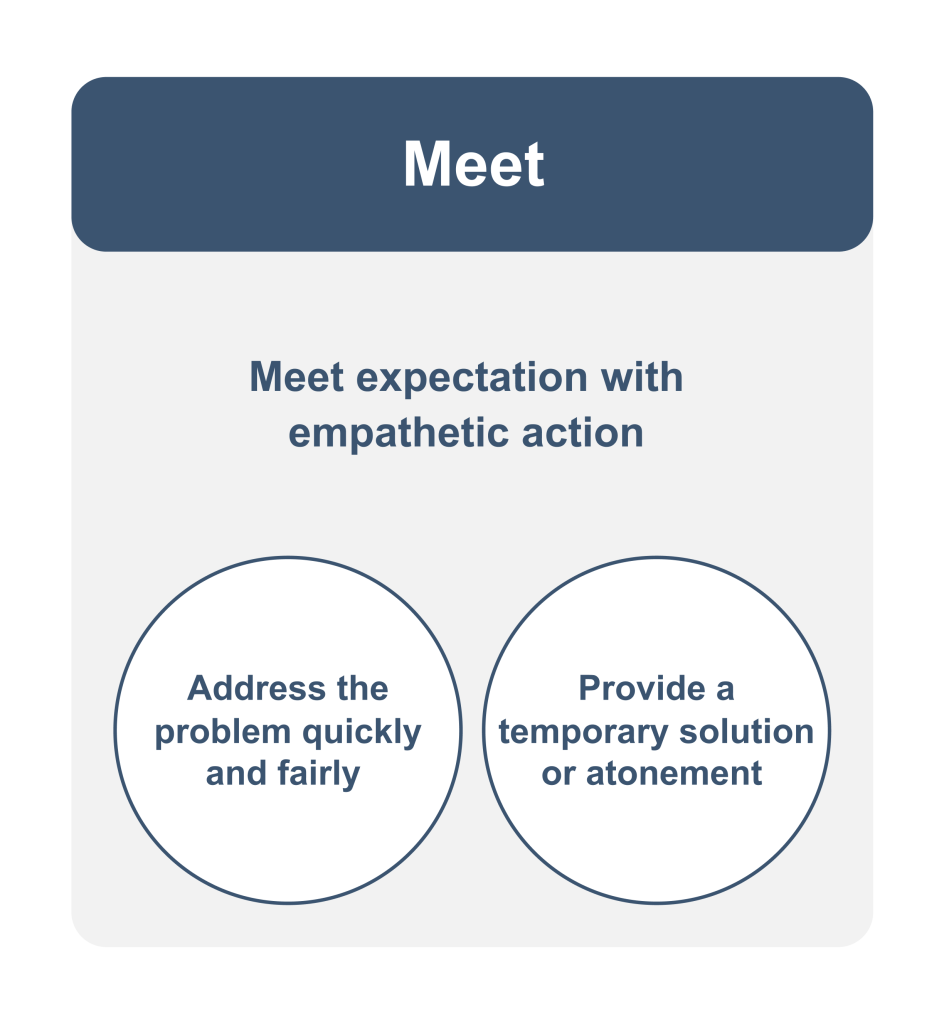
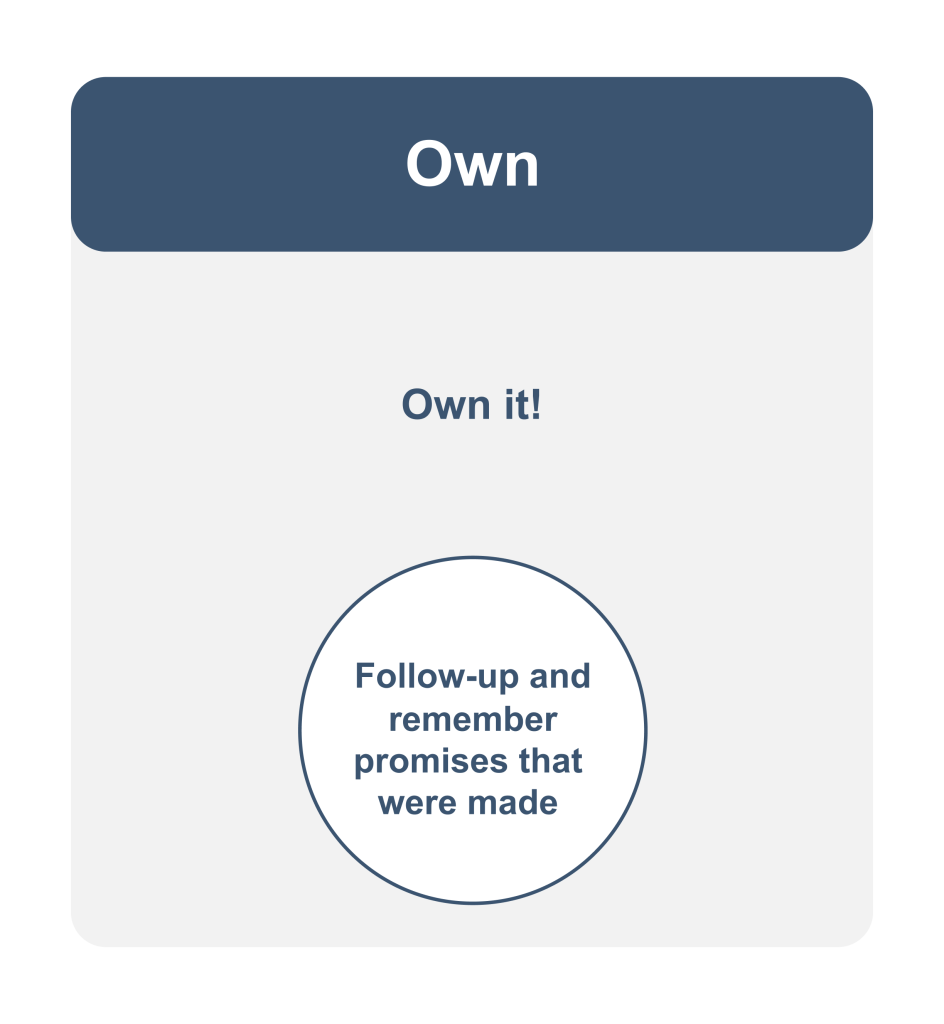
Tips
- Take a moment to pause and check-in with yourself before reacting and responding to the situation (take a deep 4-second breath)
- Check the condition of where your heart is
- Ask yourself – “What can I receive from this interaction?”
- Ask yourself – “Do I need to get support to best help this person?”
- Don’t take it personally.
Example
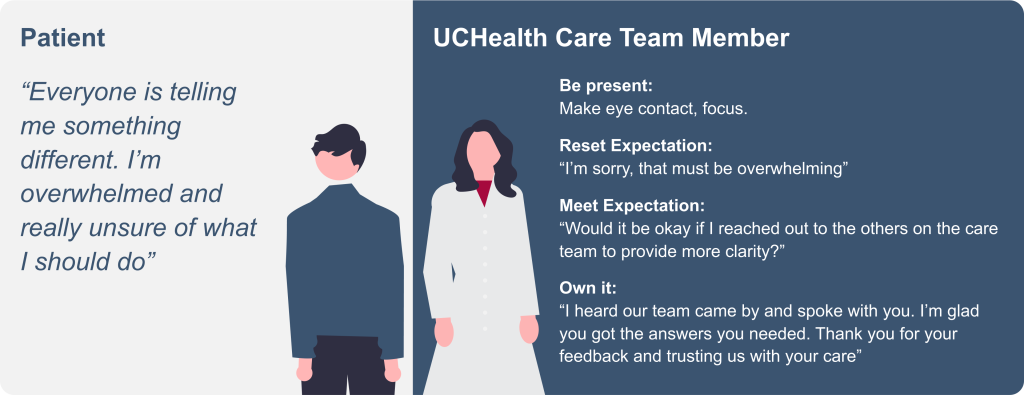
Resources
- Explore Service Recovery Resources in our SharePoint folder to deepen your understanding of service recovery.
- Review the NRC Service Alert to manage service alerts effectively within your unit.
- Get Workplace Conversation Tips to apply service recovery strategies in your daily interactions.
Set, Meet, Own
Mobility
Patient mobility is crucial for several reasons, including preventing complications, improving overall health, and enhancing quality of life. Early mobilization can help reduce hospital stays, decrease readmission rates, and improve recovery times. At every stage of a patient’s care, mobilization plays a crucial role in their healing process. Our team is committed to ensuring each patient has the support they need to achieve their mobility goals, 3 times per day.
By using the Set, Meet, Own framework, we work together to set clear mobility goals, track progress, and empower patients to take charge of their recovery. This collaborative approach leads to better outcomes and a smoother, more efficient recovery process.


What is Mobility, and Why It Matters
- Patient mobility plays a vital role in preventing complications, boosting overall health, and enhancing quality of life.
- In the hospital setting, mobility can look different than at home. It might begin with sitting up or standing, and can evolve to walking, depending on the patient’s condition.
- Set, Meet, Own helps create a structured approach for setting, meeting, and empowering patients to own their mobility goals throughout the care process.
Our goal for mobility
Our goal is to mobilize patients three time per day and track it promptly by documenting each session. Here’s how we can achieve this as a team:
3x per day
Mobilizing patients three times a day is UCHealth’s mobility goal for patient recovery. This consistency promotes healing and enhances activity independence, allowing patients to regain control over their mobility.
Track and Document Progress Promptly
It’s important to document each mobility session right after it happens. This keeps tracking clear, supports team communication, and helps patients reach their goals and recover more smoothly.
Every Care Team Member Helps with Mobilizing Patients
Every care team member (physicians, nurses, PTs, OTs, and PCAs) help mobilize patients. We are all assistants, providing encouragement, guidance, and support during each session.
Mobility Snacks
Mobility snacks, or smaller tasks such as sitting up, standing up briefly, or changing positions, are just as important as longer mobilization activities. Every small task contributes to the patient’s overall recovery.
What we want patients to know about their mobility plan?

Mobility Supports Recovery
Movement is essential for healing and overall recovery.
Everyone Can Support
Different roles support mobility in different ways. Different people will work to mobilize you.
Mobility Goal, 3x Daily
Each day, the patient and/or their supports should know the goal—aiming to mobilize at least 3 times.
A Dynamic Plan
Mobility plans may change based on progress and needs.
Regular Updates
Care team members will update the patient on their mobility progress daily.
Questions? Just Ask!
If you have any questions about mobility, don’t hesitate to ask.
How
Enhancing Mobility Communication with Set, Meet, Own
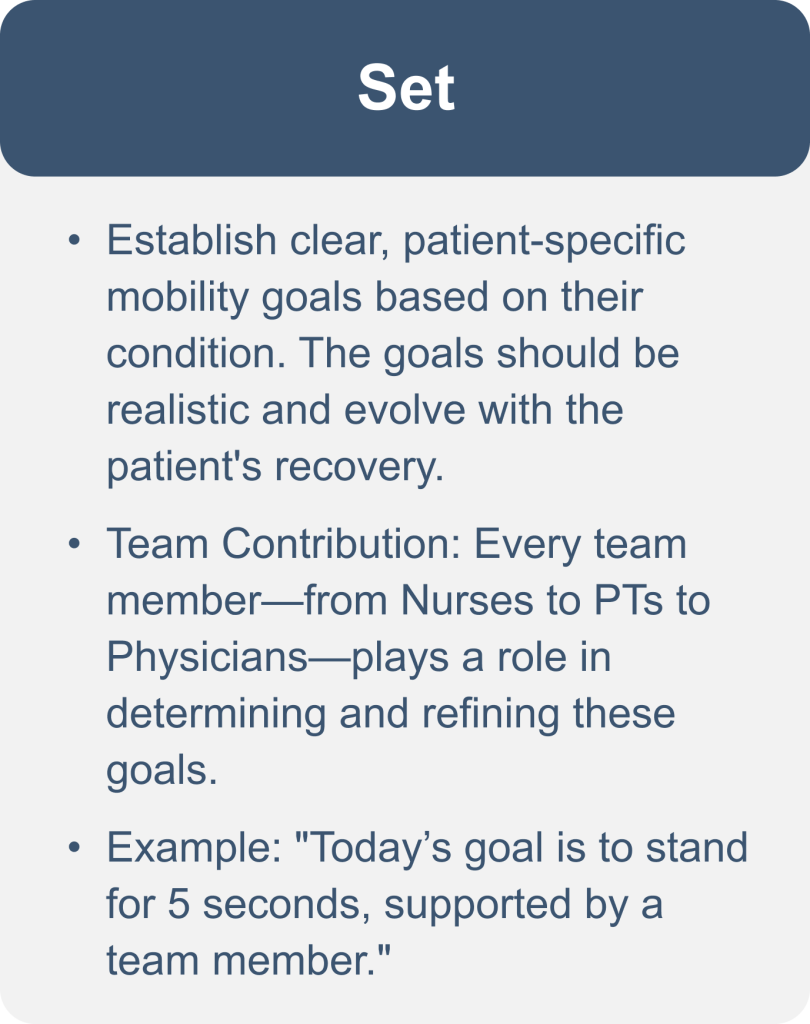
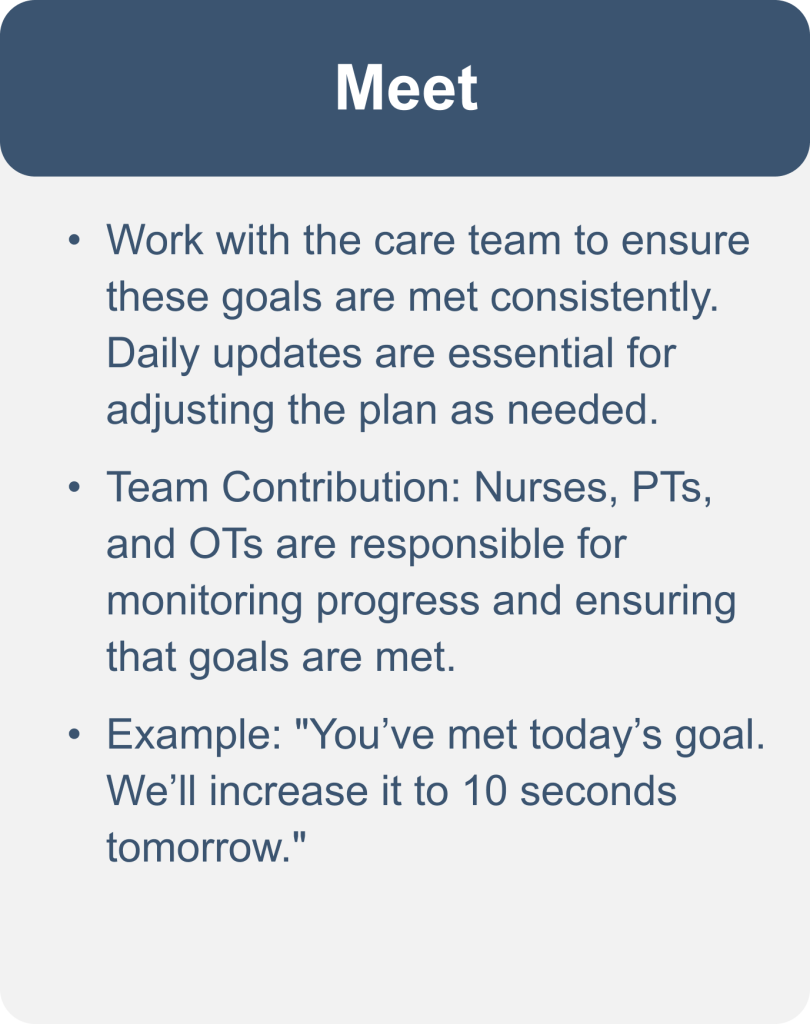
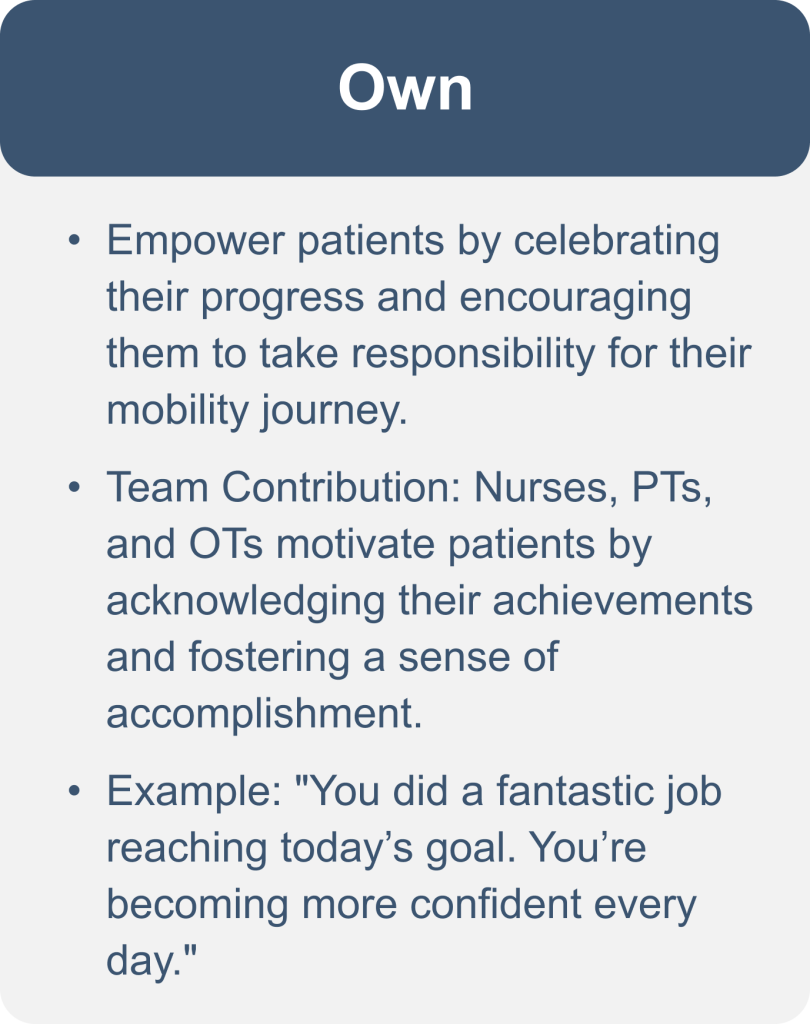
Patient mobility journey with Set, Meet, Own
Click to see how we can apply Set, Meet, Own to each stage.
Tips
Best Practices for Effective Mobilization
Be Consistent
Ensure all staff are aligned on mobility goals and update progress daily.
Communicate Clearly
Patients should always know their mobility goal for the day and what to expect. Regular check-ins are key.
Collaborate
Nurses, PTs, OTs, and Physicians must work together to address challenges and support the patient’s progress.
Celebrate Small Wins
Every step forward is important. Recognize small victories to encourage continued progress.
Examples
How can you apply Set, Meet, Own, to your role in mobilizing patients?
These examples provide practical guidance on how to integrate the Set, Meet, Own, framework into your daily mobility work at UCHealth. Learn how different roles contribute to mobilizing patients and how you can apply this framework to support patient recovery. Click on any thumbnail below to view detailed examples for each role and see how mobility goals are set, met, and owned.
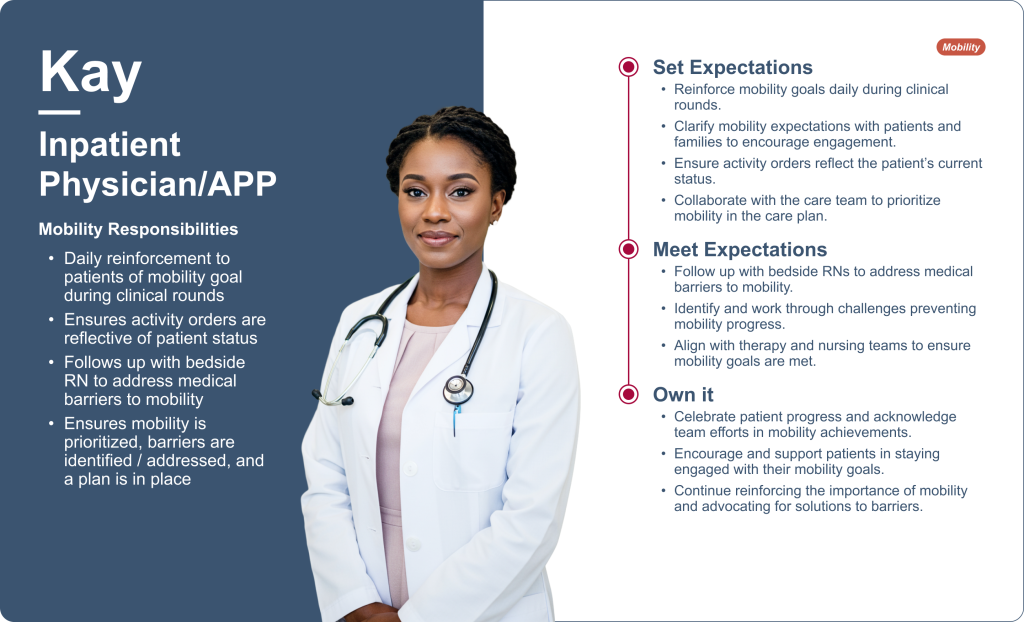
(Inpatient)
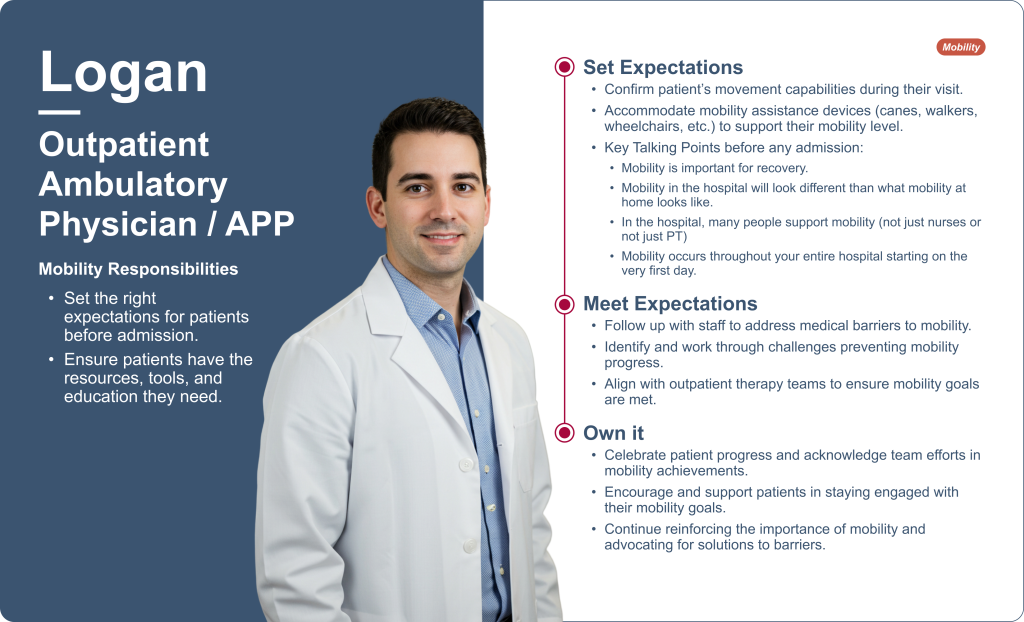
(Outpatient)
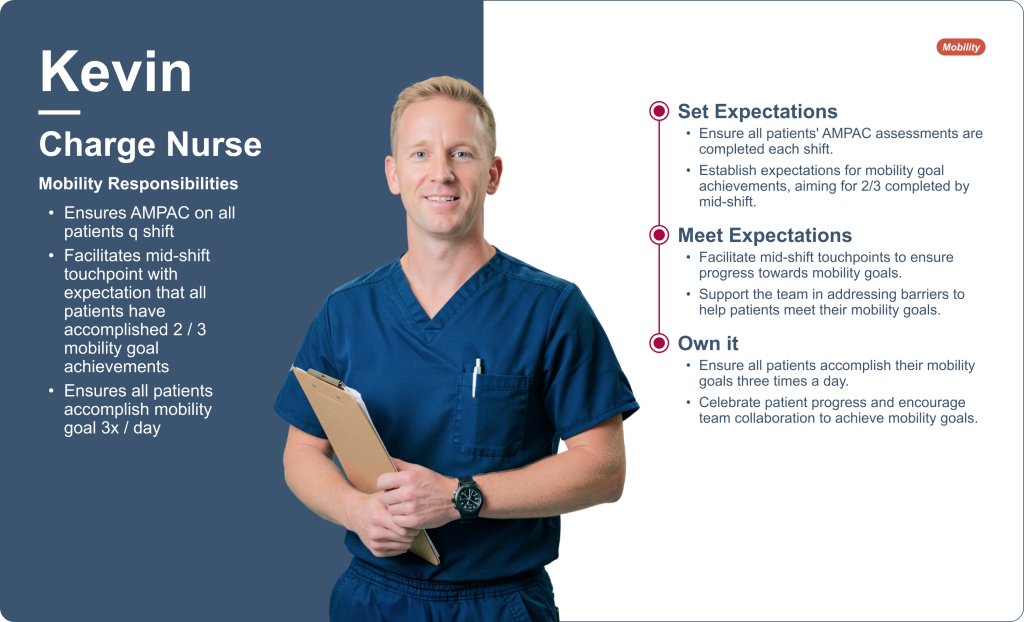
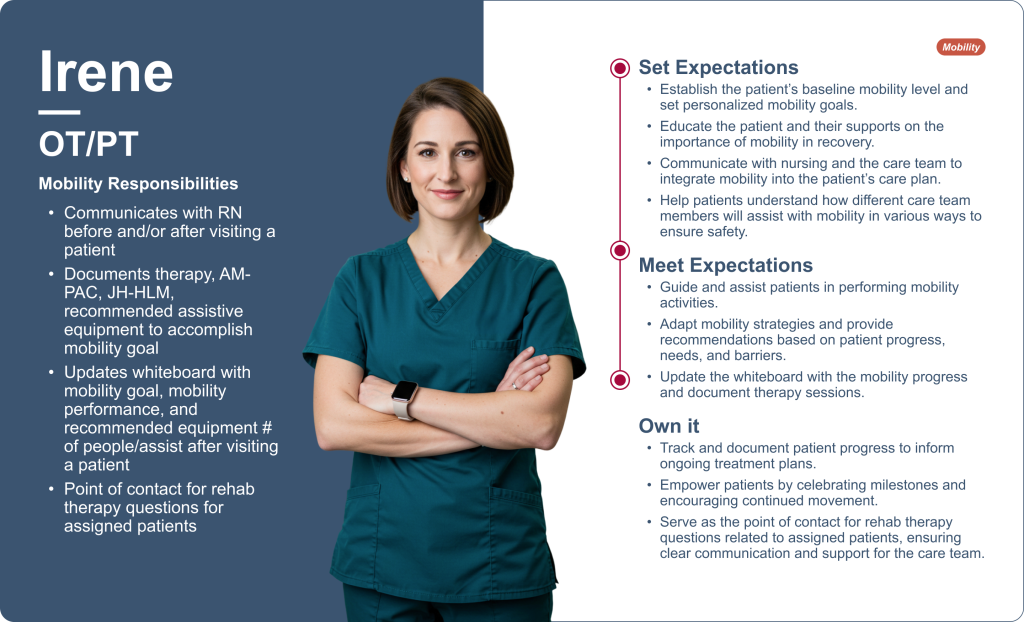
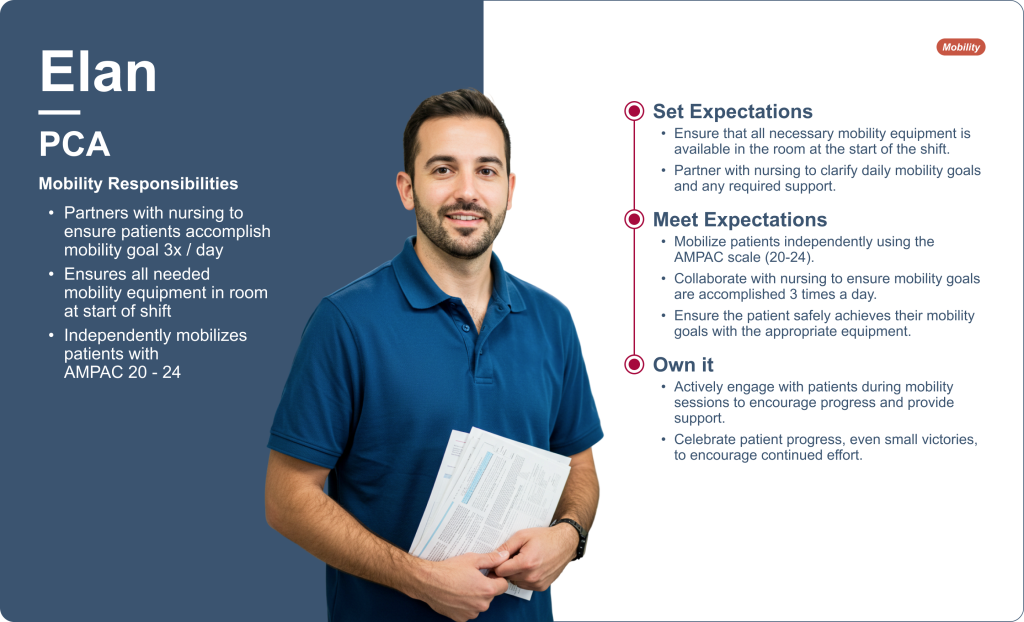
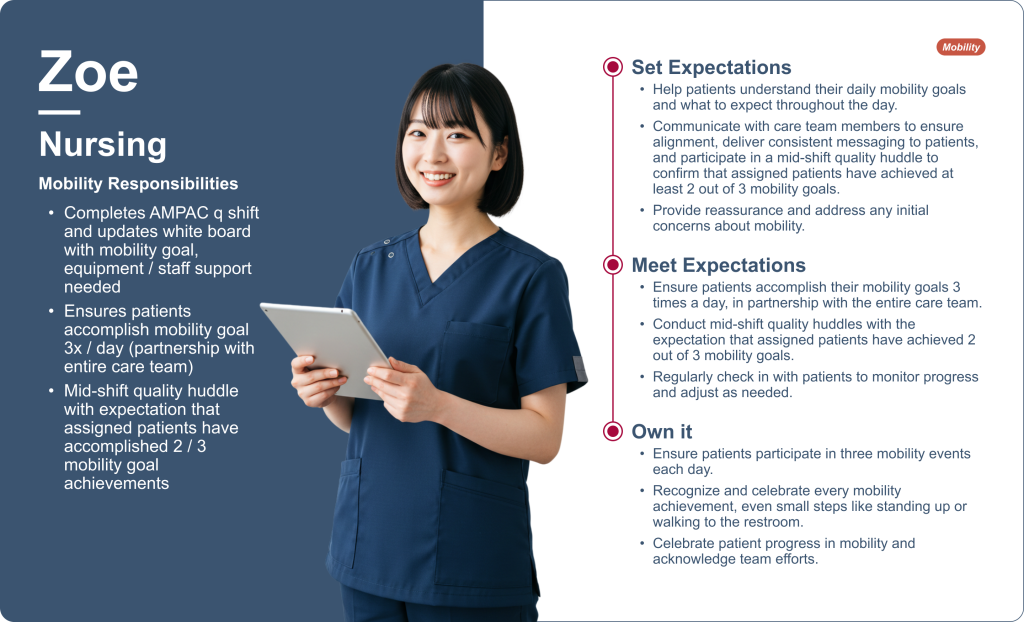
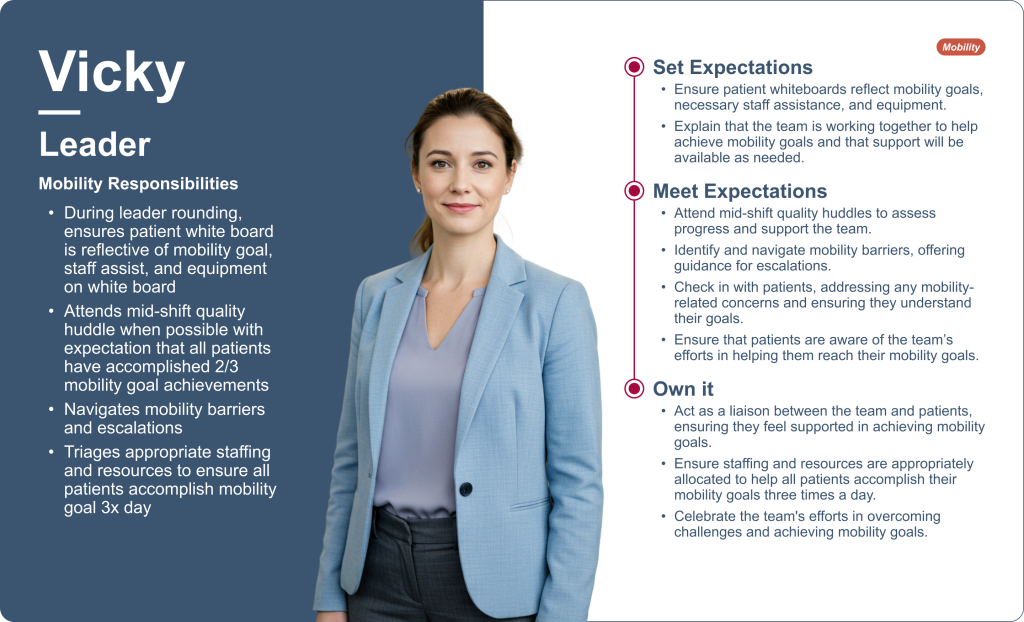
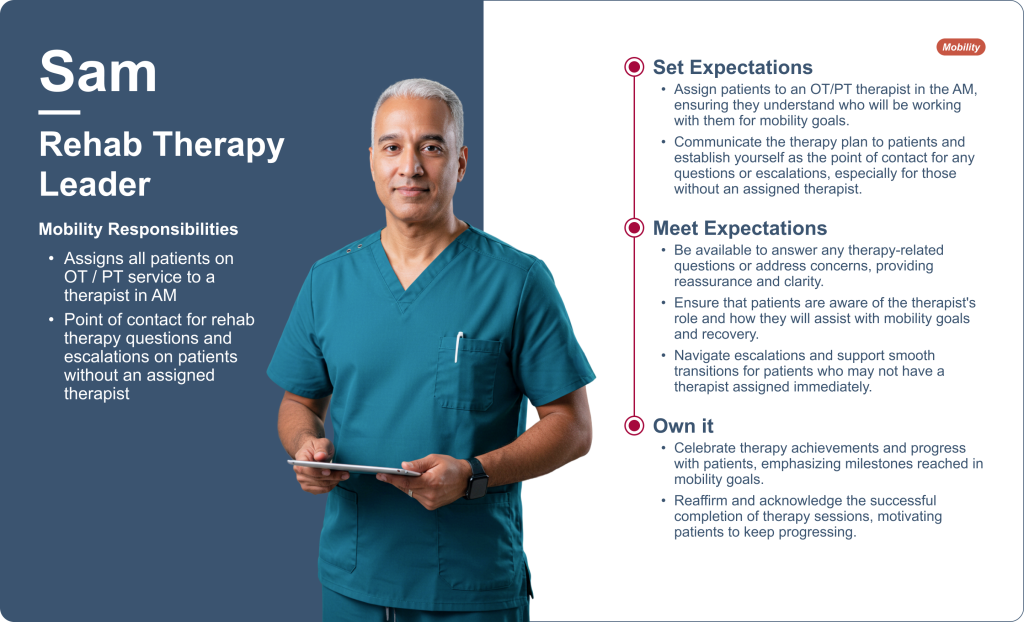
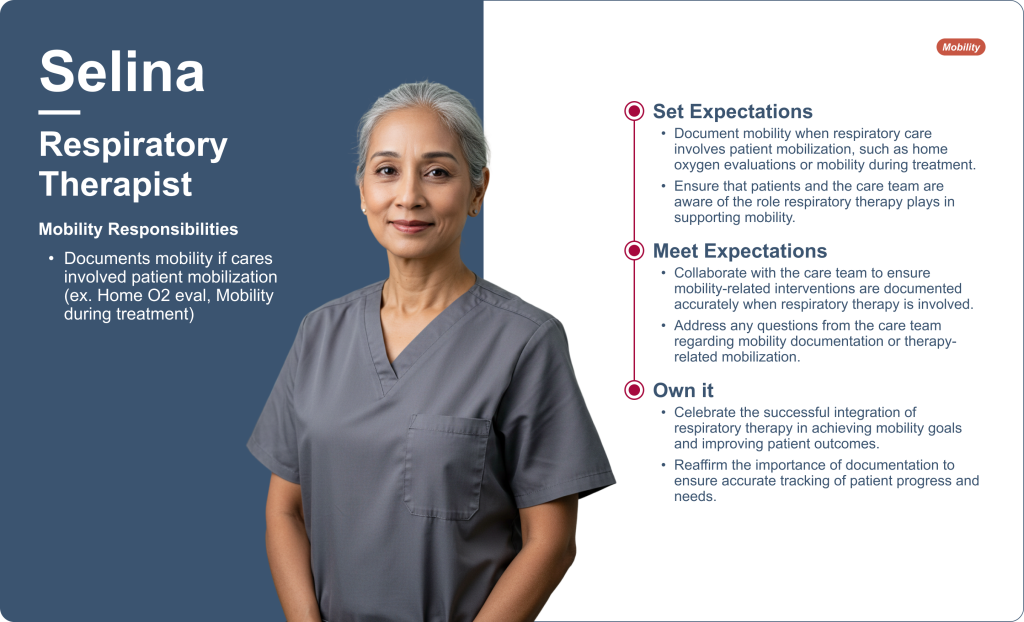
Where can you find all the mobility examples?
Want to explore all the mobility examples? Head over to Sharepoint, where you can download them at any time.
Resources
- Explore additional mobility resources on the Mobility Team Page to enhance your understanding and support your role.
Set, Meet, Own
All Resources
Find everything you need to support your work, improve patient experiences, and stay on top of your responsibilities—all in one place.
Need a personalized approach? Reach out to the Experience Team to explore how we can partner with you to customize the Set, Meet, Own service framework for your team.

Set, Meet, Own
- Dive into Set, Meet, Own Examples in our SharePoint folder to see how this approach works across different roles and the positive impact it has on patients when expectations are successfully set, met, and owned.
Rounding
- Jump into the Rounding App and get started!
(You’ll need both a UCHealth email and Epic access to use the Rounding App. If you don’t have either, please submit an ITSM request for access.) - Explore the Support Resources in our SharePoint folder full of helpful Rounding App docs.
- Check out the Power BI Rounding Report for detailed insights (best viewed on desktop).
Service Recovery
- Explore Service Recovery Resources in our SharePoint folder to deepen your understanding of service recovery.
- Review the NRC Service Alert to manage service alerts effectively within your unit.
- Get Workplace Conversation Tips to apply service recovery strategies in your daily interactions.
Experience Design
Experience and Innovation at UCHealth
Experience and Innovation at UCHealth focuses on transforming health care by enhancing patient experiences through cutting-edge and accessible technology, research, and innovative experience solutions. UCHealth is committed to creating a compassionate, responsive health care environment to improve our patients’ health outcomes.
UCHealth’s patient experience initiatives are built around intimately understanding patient needs, reducing fear and anxiety during care, and creating a more connected and seamless care journey.

UCHealth’s Patient Experience Foundations

Our work emphasizes digital innovations to make health care more accessible & convenient.
What Does the Experience and Innovation Team Do?

Experience Design turns complex challenges into coordinated, compassionate, and efficient care.
The quick answer is we spend a lot of time thinking about how to make health care more compassionate, personalized, and accessible for patients – and easier for care teams to deliver that care effectively.
We use Experience Design to reimagine complex and highly matrixed processes to make every patient step feel intuitive, supportive and, well, human.
Experience Design works in health care because it is not just about fixing pain points but it is about anticipating needs, streamlining processes, and designing interactions that makes a patient, their families and UCHealth staff feel at ease and confident, empowering care teams to work smoothly.

The UCHealth Experience
At UCHealth, we use the Set, Meet, Own framework as a foundation for how we engage with each other, patients and their families. This framework was built by UCHealth patients and staff during a system-wide and thorough Experience Design process.
The Set Meet Own service framework is designed to enhance the quality and consistency of patient experiences by setting, meeting, and owning expectations.
This approach helps alleviate common pain points and barriers, allowing patients & their families to focus on clinical care rather than navigating service-related interactions.
You can apply the Set, Meet, Own framework in your daily work. Additionally, there are digital tools available that can empower you, to implement this framework efficiently.
Digital Experience
Enhance the Patient Experience with Digital Tools
Digital Experience
Our mission is to give UCHealth patients tools that are best in class, in or out of the health care industry, so our patients can stop worrying about what button to push and focus on the relationships and care that help them live extraordinary lives.
Here, you’ll find a range of tools to support you in improving patient engagement, communication, and access to UCHealth’s digital services. Each tool offers unique capabilities to help staff deliver a seamless and personalized experience for patients. Learn more about each tool below & how to get in touch with us.
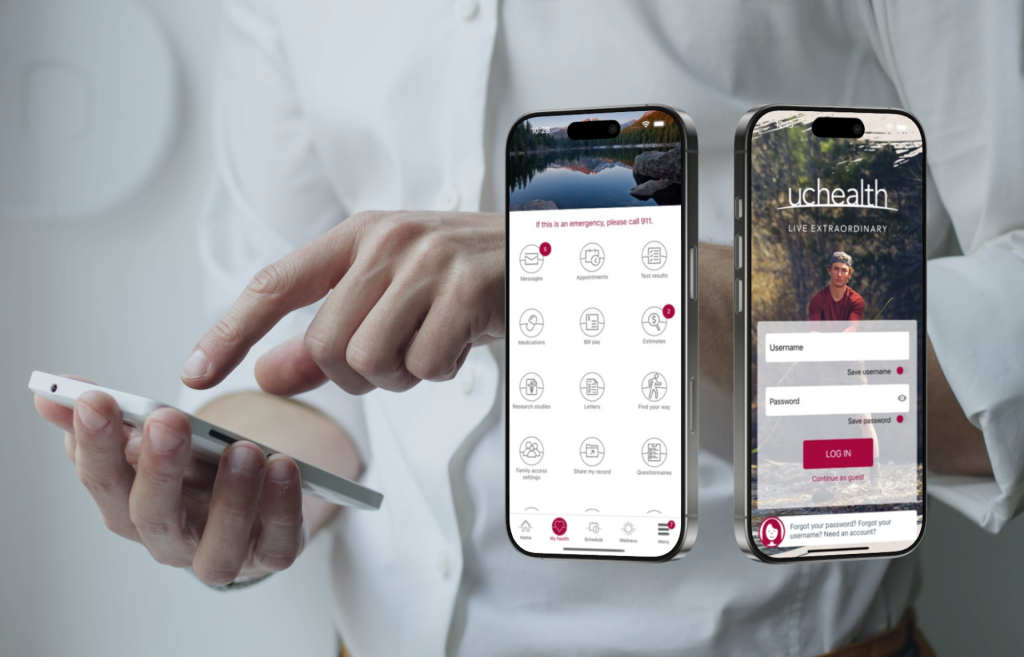
Digital Tool
My Health Connection
Empower patients with personalized, timely information.
My Health Connection (MHC) is our patient portal, which enables you to engage with patients online and keep them connected to their care. Use MHC to communicate with patients and manage care journeys.
We can help you:
- Update text or instructions on pages (where allowed by Epic)
- Send bulk messages through My Health Connection
- Make language changes to system-wide automated emails, texts, and push notifications
- Post homepage announcements
- Design and implement patient questionnaires
- Update workflows and patient journeys within the portal
- Roll out new features
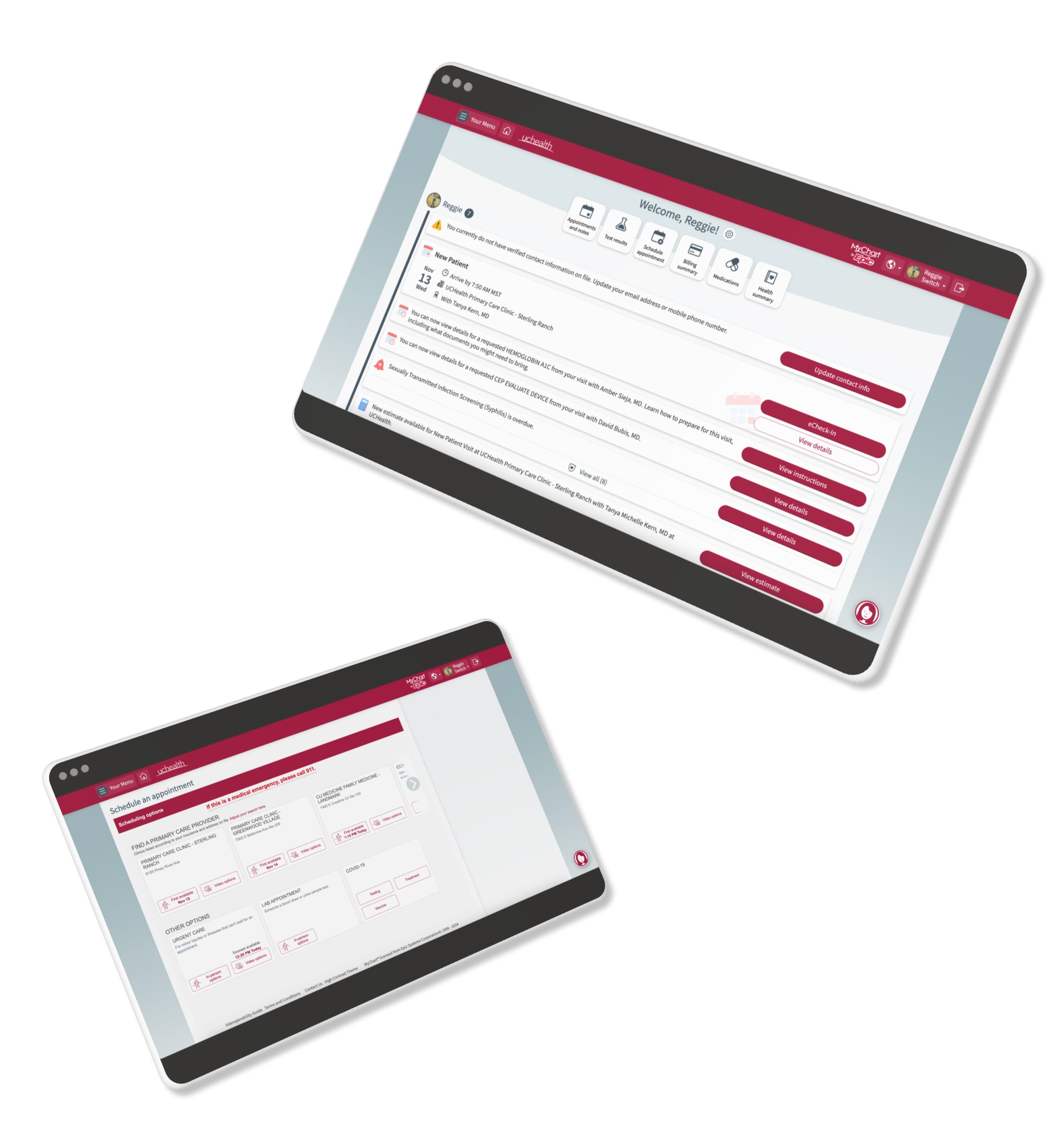
Have any feedback or ideas for MHC?
Digital Tool
uchealth.org
Enhance the online presence of your department.
uchealth.org serves as our main digital front door, providing critical information for patients and the public. With the ability to update or create pages, you can ensure your department’s online content is accurate, accessible, and engaging.
We can help you:
- Update existing pages
- Create new pages
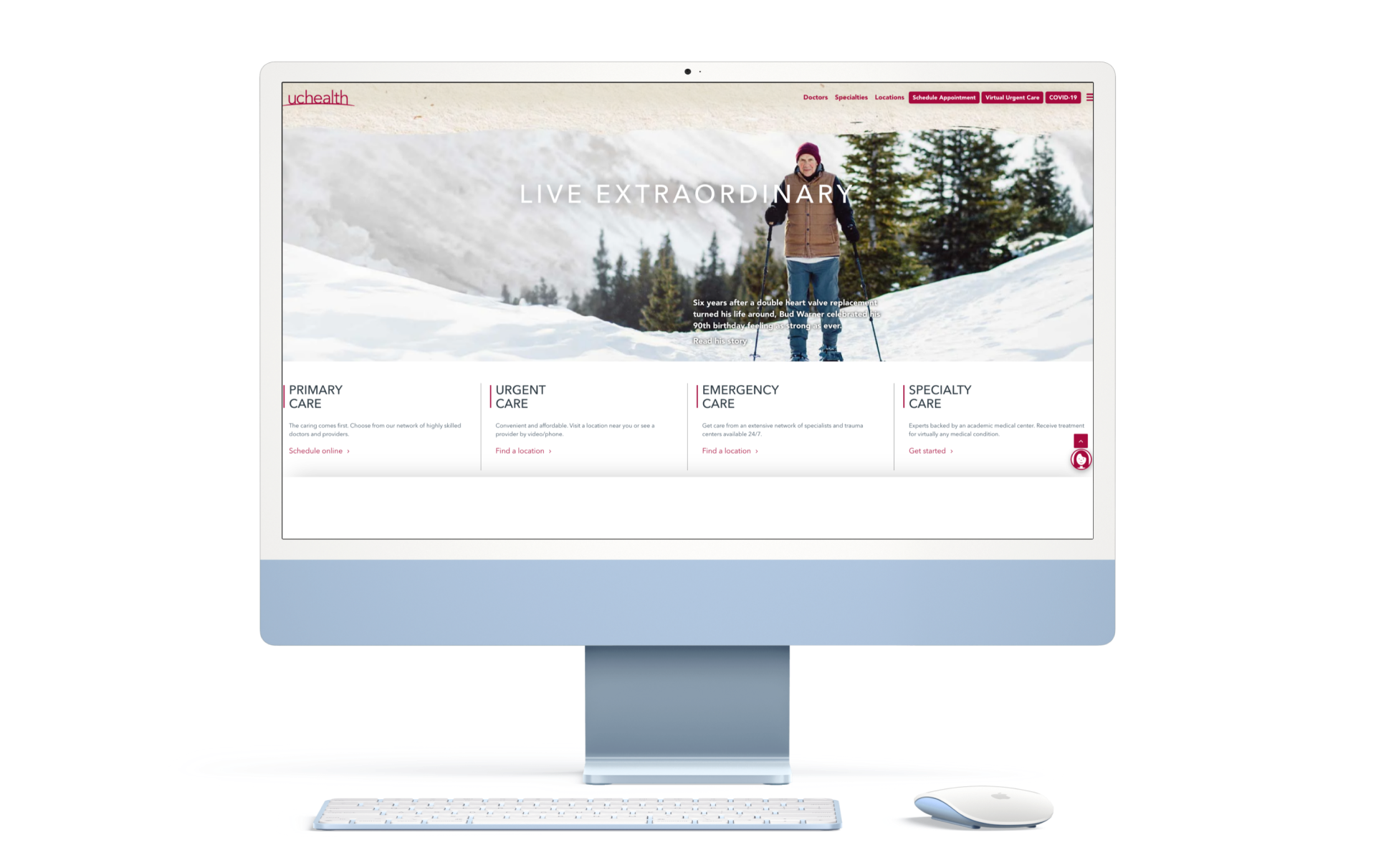
Need to add, delete or update a Provider Profile?
Do you need updates on uchealth.org?
Digital Tool
UCHealth App
Bring health care directly to patients’ fingertips.
The UCHealth app offers patients convenient access to care and information on the go.
People often ask,
“What’s the difference between the UCHealth app and My Health Connection?”
Good question. The UCHealth app is My Health Connection and more –– wellness features, blogs, and way-finding, to name a few. Like MHC, you can use this tool to manage care journeys, post key announcements, and communicate with your patients while they’re on the go.
We can help you:
- Update text or instructions on pages (where allowed by Epic)
- Post homepage announcements
- Update workflows and patient journeys within the app
- Implement new features
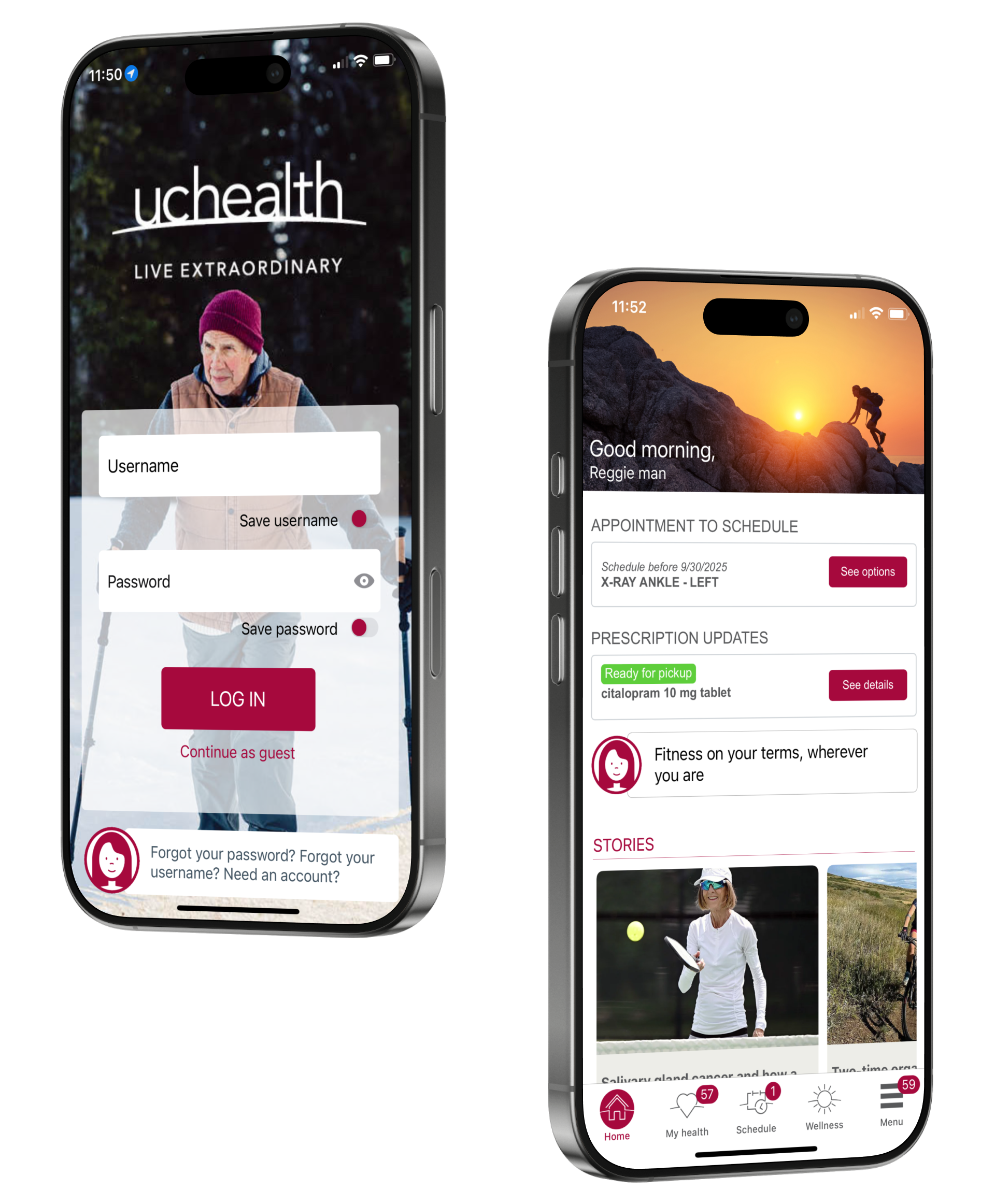
Have any feedback or ideas for the UCHealth App?
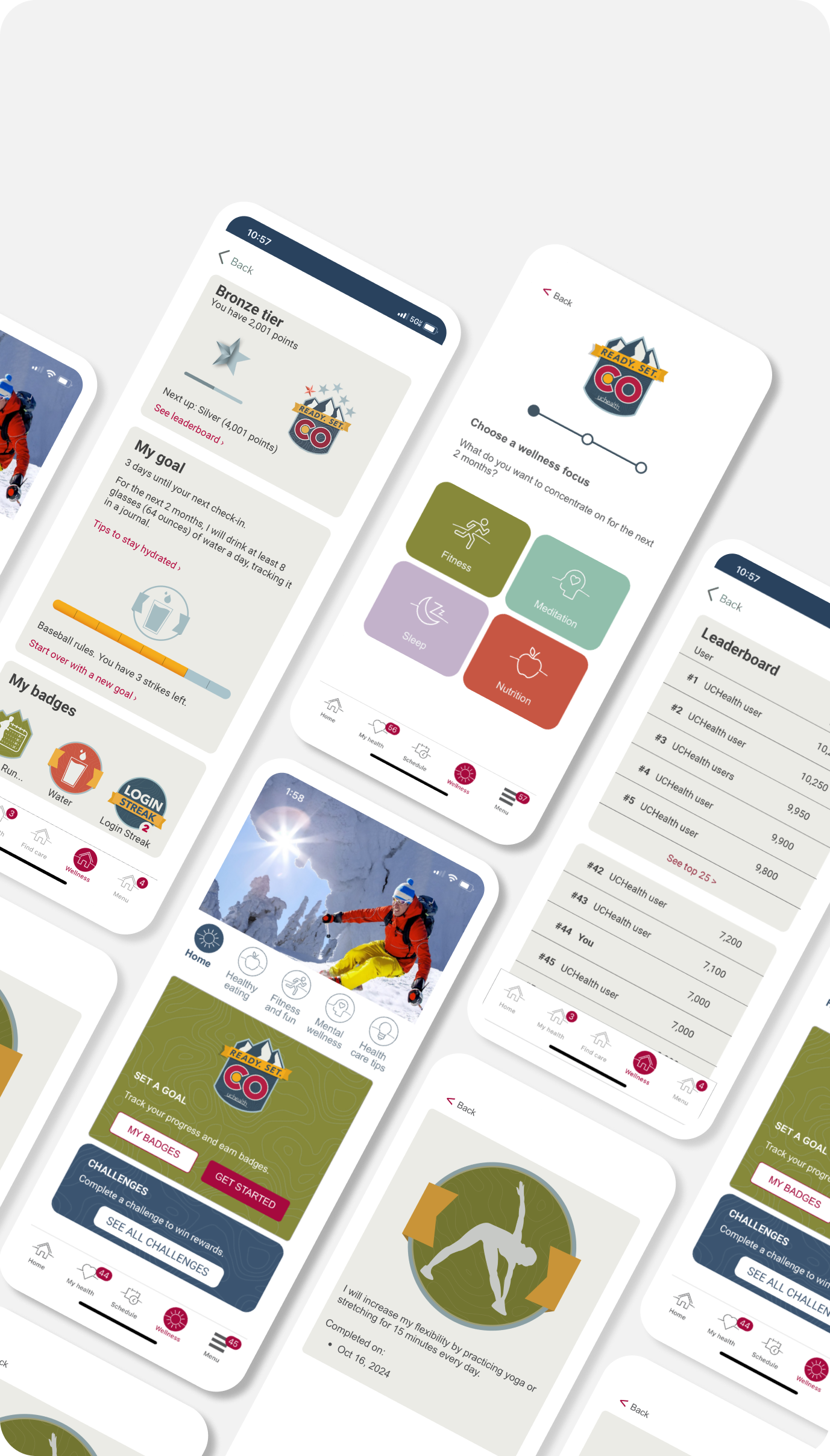
UCHealth App
Wellness and Rewards Program
Take action for a healthier you – Within the UCHealth App
The UCHealth Wellness feature empowers you to build healthier habits through wellness challenges and personalized goals in fitness, nutrition, sleep, and meditation. Earn points and unlock rewards from UCHealth’s Ready. Set. CO partners, giving extra motivation to become the healthiest version of yourself. By combining gamification with an evidence-based approach, this program inspires you to take charge of your health, with actionable steps, while making meaningful health improvement fun and rewarding.
How can this support your wellness journey?

Have any feedback or ideas for the UCHealth App?
Digital Tool
Livi
Explore the potential of conversational AI in patient support.
Livi, our AI assistant, is available 24/7 to help answer patient questions, automate manual workflows, and support other department-specific needs.
With Livi, we can help:
- Educate patients about various health conditions and wellness tips
- Show patients how to use My Health Connection and the UCHealth app
- Automate manual communication workflows via text messages, phone calls, and My Health Connection messages
- Route inbound phone calls conversationally and effectively
- Educate staff about benefits, care at UCHealth, and other policies
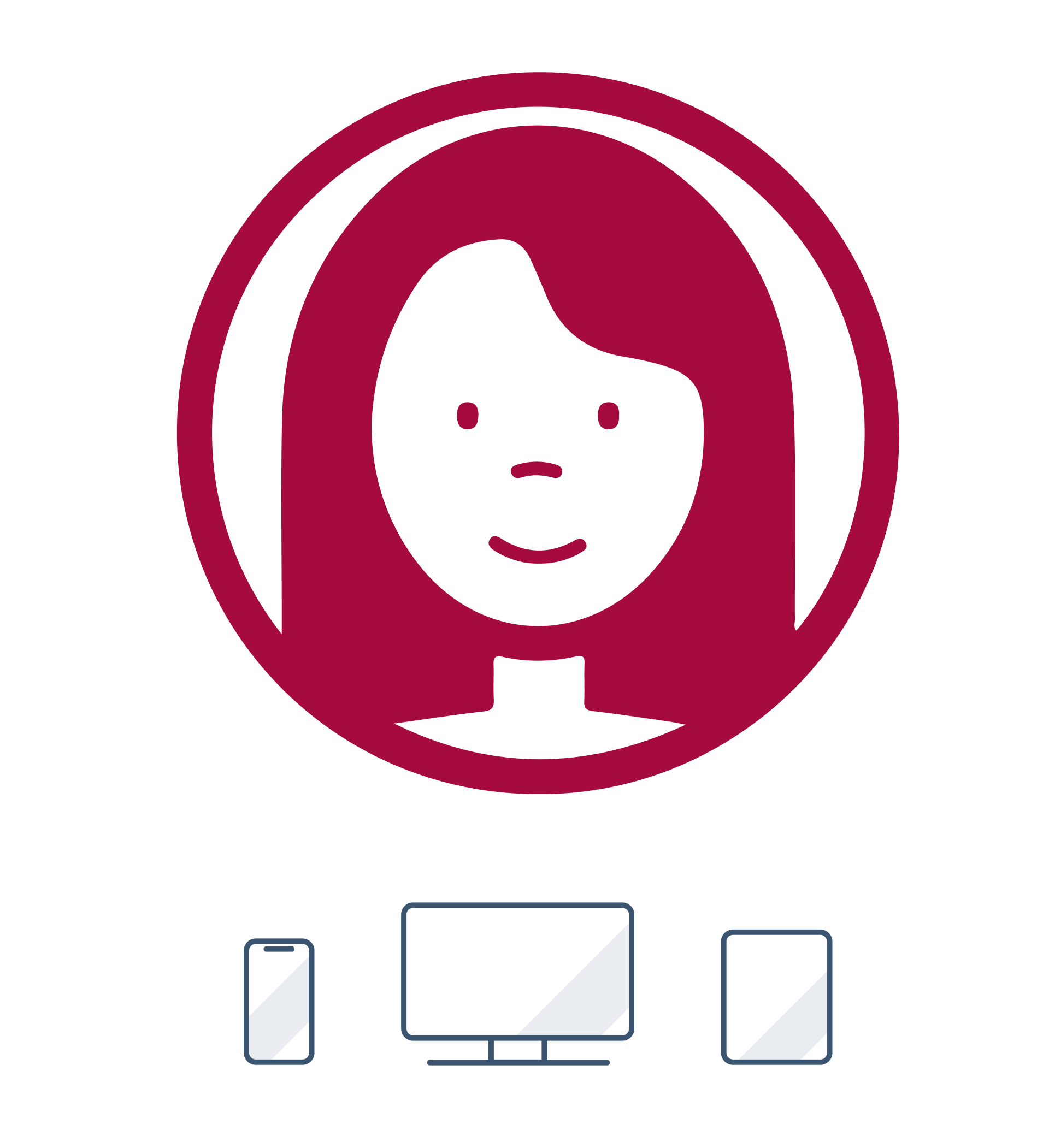
Have any feedback or ideas about Livi?
Digital Tool
UCHealth Virtual Reality (VR) Program
Immersive care that transforms patient experiences.
The UCHealth VR Program provides clinical staff with an innovative tool to enhance patient care and alleviate staff burdens through VR distraction therapy.
People often ask,
“What is VR distraction therapy, and how does it help?“
Great question. VR distraction therapy uses immersive virtual experiences to help patients manage discomfort and pass the time during treatments like infusions or procedures involving needles or surgery. Patients can explore serene landscapes, travel the world, or enjoy calming activities – all from their treatment chair. This approach has proven to enhance the patient experience and provide relief during challenging moments.
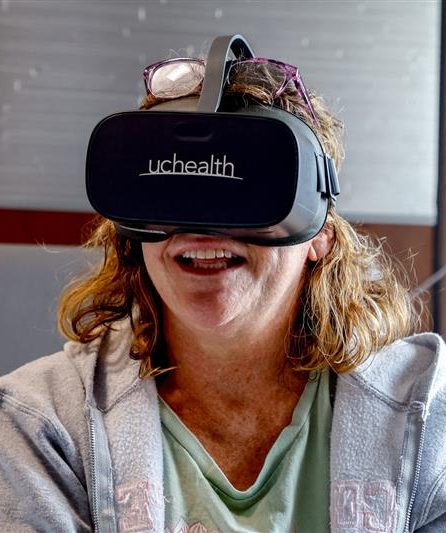
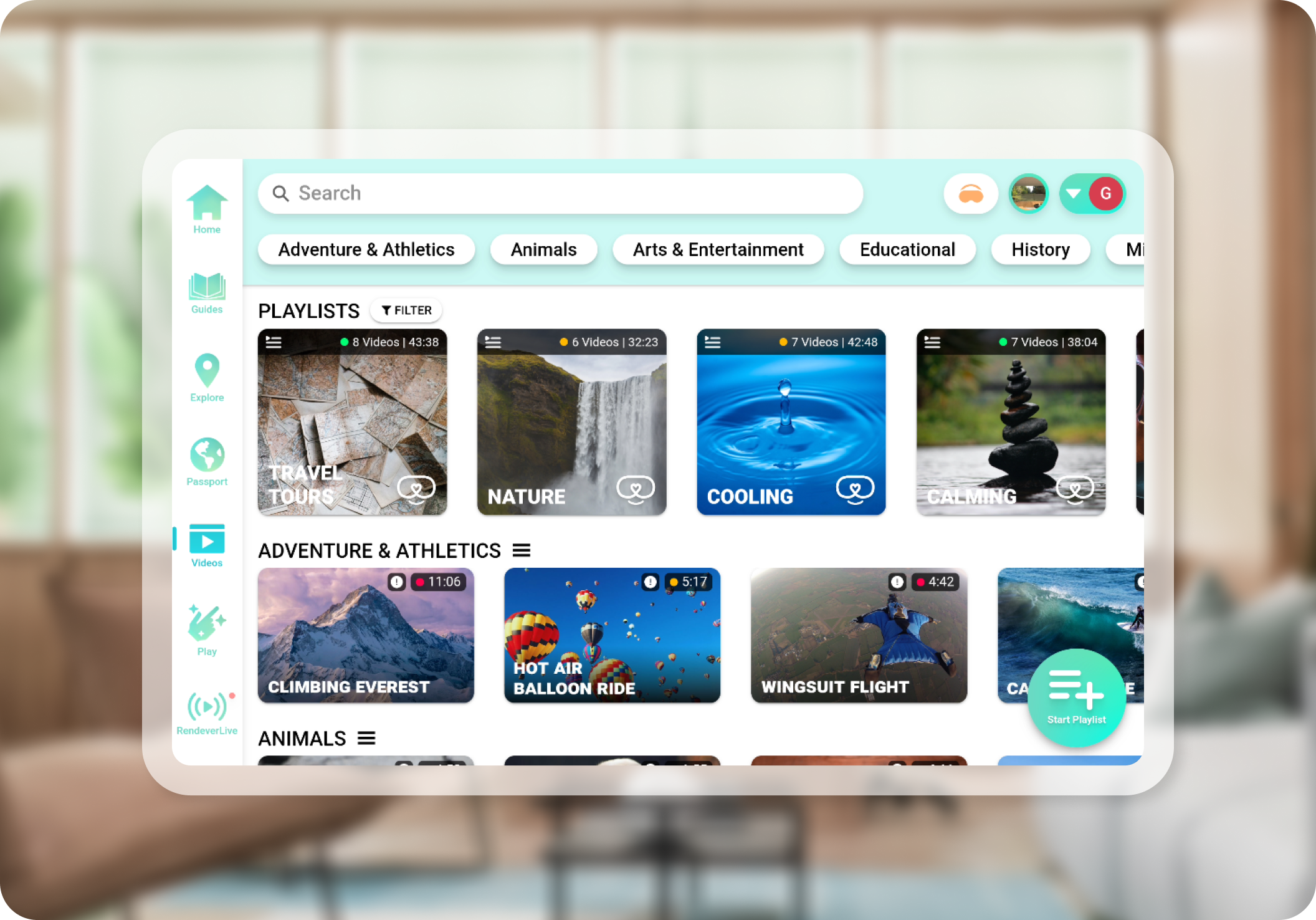
With VR systems in 14 UCHealth hospitals and over 200 trained VR Champions, we’re ready to help you deliver exceptional care.
We can help you:
- Train staff as VR Champions to operationalize Virtual Reality.
- Provide insights and resources to seamlessly integrate VR into patient workflows.
- Deliver tools to identify patients who would benefit from VR experiences.
- Offer ongoing support to optimize the use of VR systems.
Have any feedback or ideas for the VR program?
Please email [email protected]
VR in Action
Check out how UCHealth’s VR Program is making a difference in patient care in this CBS News video. The idea is to give patients an opportunity to have another experience while getting treatment.
Experience Data
Experience Data
Within the Experience space, everything we do is informed by data. We leverage quantitative and qualitative data to make informed decisions that drive higher impact solutions. Experience data also allows us to set measurable goals and lead actionable improvements.
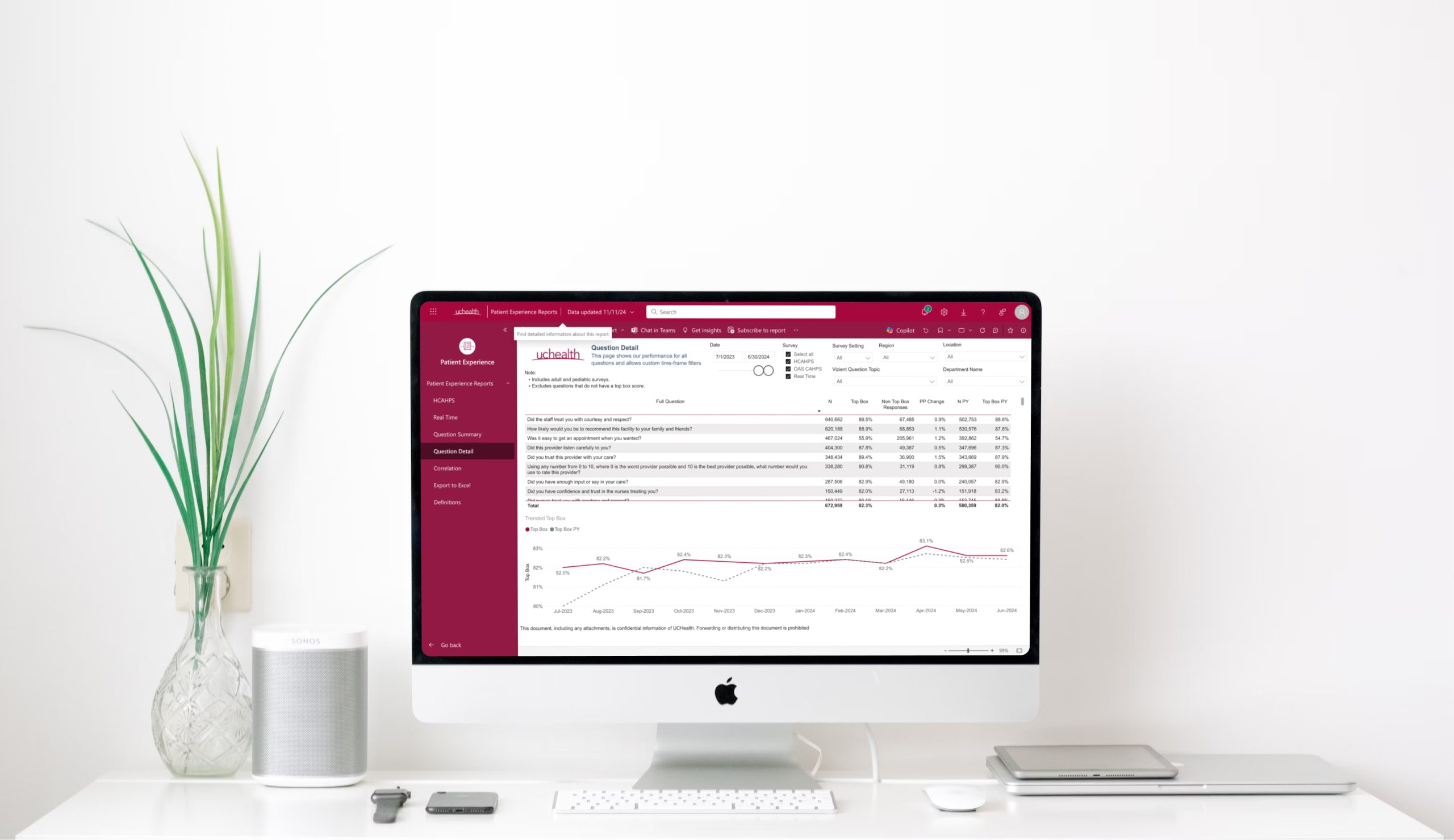
How
The primary way we receive experience data is through returned patient surveys after they receive care from us. The three surveys the Experience and Innovation team manages are HCAHPS, OAS CAHPS and Real Time. These surveys include standardized questions that allow us to evaluate performance, as well as an opportunity for patients to leave open-ended comments.
Patient experience data are also gathered through patient rounding logs, RL reports, 3rd party reviews and feedback from our patient-facing teams.
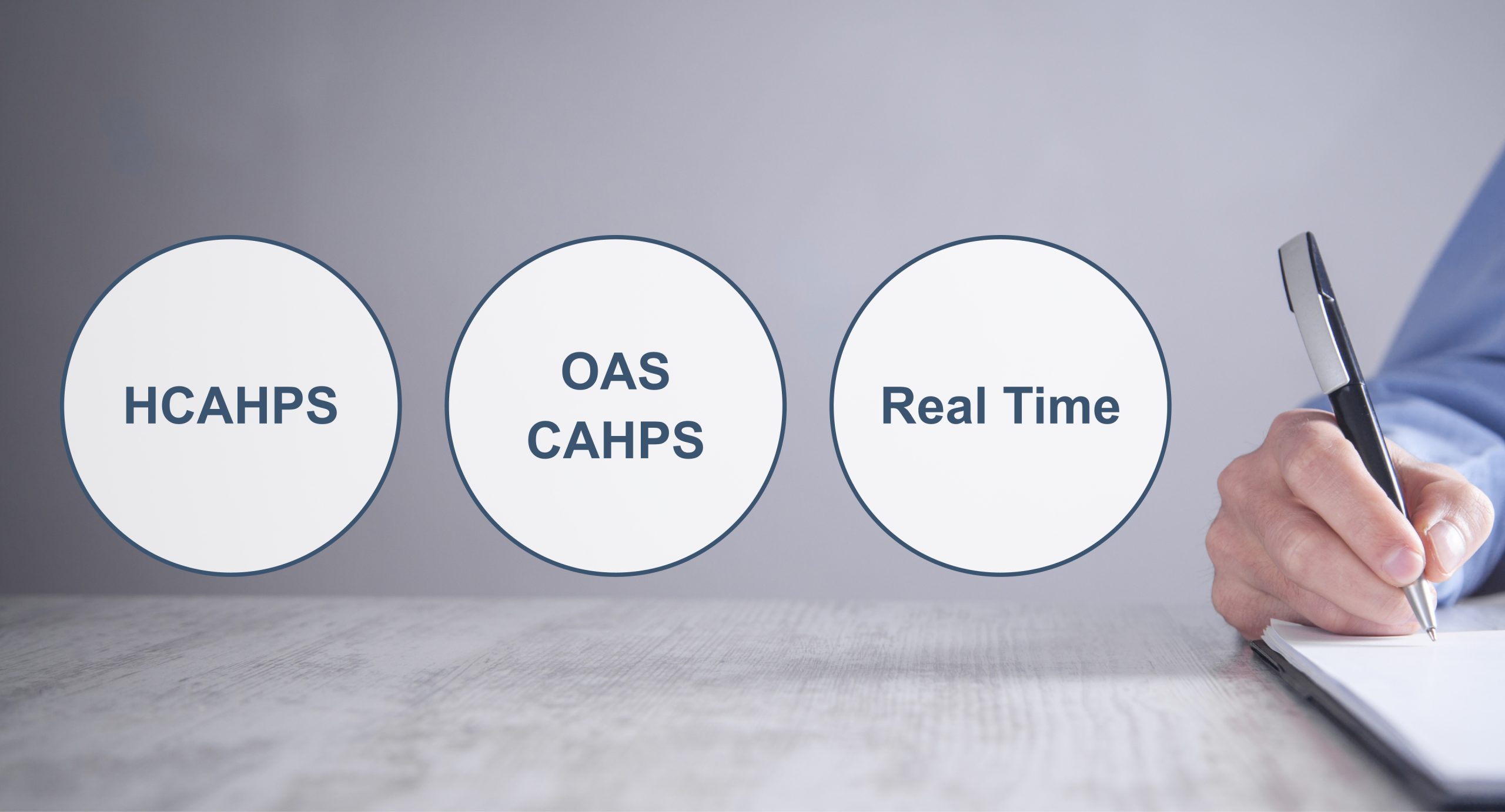
Dashboards
The following dashboards are used to access all patient experience survey responses. The dashboards have various reports (pages) that analyze and visualize data in different ways.
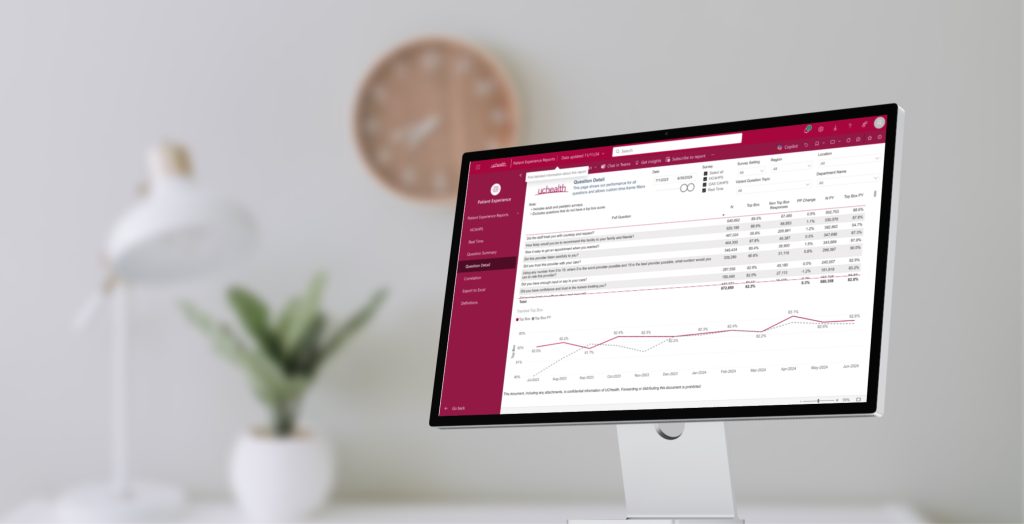
PowerBI
Patient Experience Reports Dashboard
The dashboard contains all patient survey responses except patient comments. Scores can be filtered down to the department level. Use this dashboard to see patient experience scores, identify opportunities, and create goals.
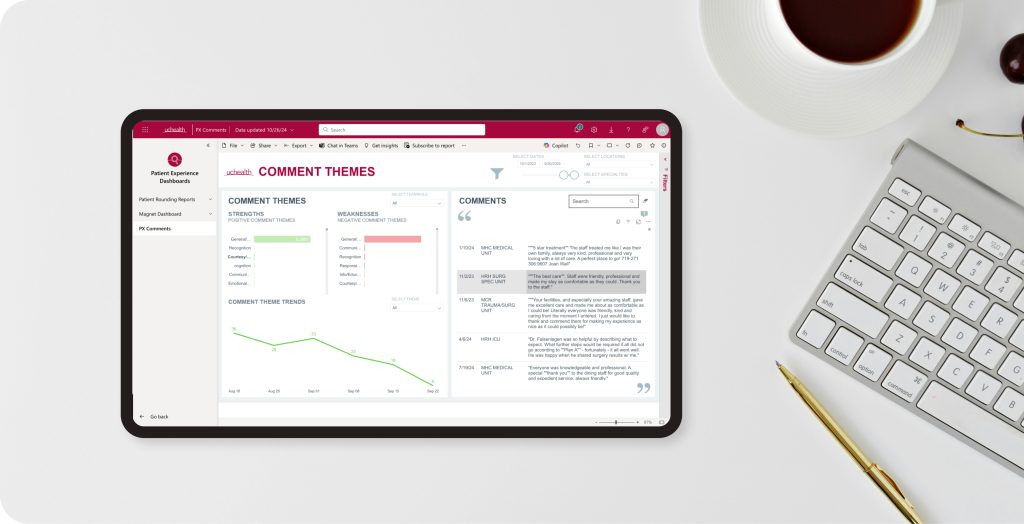
PowerBI
Patient Experience Comments Dashboard
The dashboard contains all patient comments received in all patient experience surveys (HCAHPS, OAS CAHPS and Real Time). Comments are also filtered to the department level.
Power BI Walkthrough

Join our Experience team for a 1-hour training session on the Patient Experience Power BI dashboards, held monthly on
the third Wednesday from 10:00 am to 11:00 am.
To register for an upcoming session, click the button below.
NRC Experience
The NRC dashboard provides all the insights found in the Power BI dashboards, with added access to PHI, provider-specific scores, and service alerts (automated notifications for comments flagged as negative).
This level of access is reserved for select leaders. If you need access to the NRC dashboard, please complete the form below to specify your required locations and access level.
Experience Goals
System-wide annual experience goals and resources for setting and tracking goal progress are available here.
Experience Innovation Partnerships
Breaking Industry Norms
Brand Innovation and Experience Partnerships
At UCHealth, we redefine health care by creating partnerships that extend far beyond the hospital. These collaborations focus on equipping our patients and communities with the tools and resources to live healthier, more extraordinary lives.
By embracing unconventional ideas and breaking traditional industry norms, we connect patients with solutions that empower them to thrive. Whether it’s through innovative technology, wellness programs, or partnerships that challenge expectations, UCHealth is committed to being more than a health care provider—we’re a lifestyle partner.
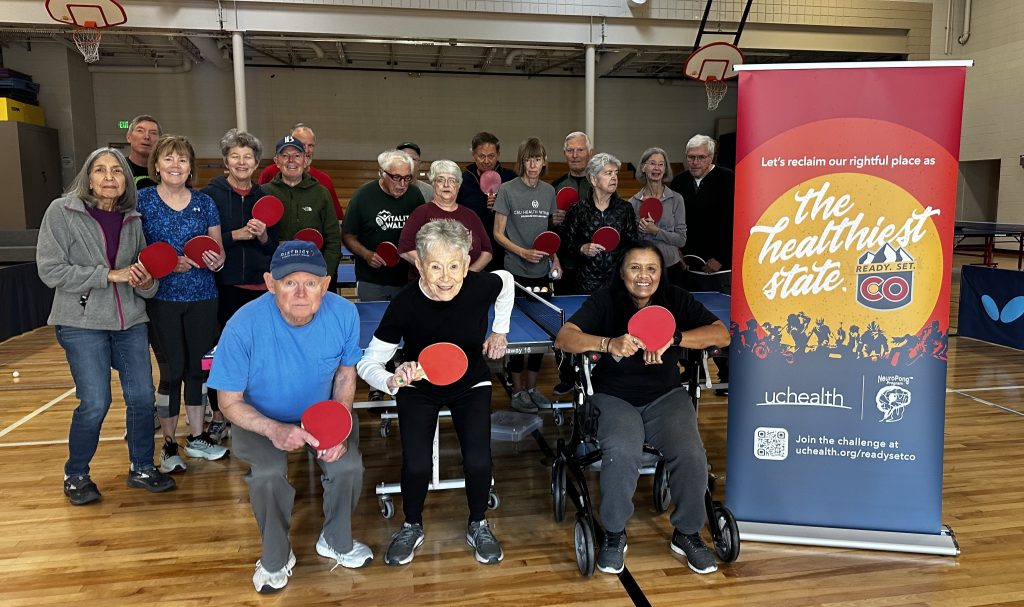
How we’re innovating for impact
UCHealth’s experience innovation partnerships are driven by a bold vision: to empower individuals and communities to prioritize health and well-being every day.
Innovating Beyond Health Care
We’re reshaping what health care means by focusing on prevention and wellness as much as treatment. By collaborating with unconventional partners, we offer solutions that inspire patients to live their healthiest lives outside of hospital walls.
Building Patient-Focused Solutions
From personalized digital tools to community wellness initiatives, every project starts with a focus on making life healthier, easier, and more extraordinary for our patients
Partnering for Impact
Our partnerships go beyond traditional health care boundaries. We work with organizations that share our vision to deliver programs and tools that improve lives, strengthen communities, and make wellness accessible to all.
Creating Healthier Communities
UCHealth doesn’t just treat individuals; we’re here to make Colorado healthier. Through challenges like Ready. Set. CO, and other wellness initiatives, we aim to inspire lasting change across the state.
The power of innovation
At UCHealth, innovation isn’t just a buzzword—it’s how we redefine health care. Through bold thinking and dynamic partnerships, we collaborate with organizations across industries to deliver groundbreaking solutions. These efforts empower our patients and our team to create extraordinary experiences and lead healthier, more fulfilling lives.
Experience Innovation Partnerships
Explore Ready. Set. CO
Colorado is built for people who want to explore, play, and move. For years, Coloradans have prided themselves on being one of the fittest, strongest, healthiest populations on the planet. But that’s not the case anymore. We’ve slowed down. But our state, in all its mountainous, sun-shining glory, is still there to support us —and so is UCHealth.
What is Ready. Set. CO?
A state-wide challenge to make us the healthiest state and get Colorado back to the summit of good health.
The goal of the program
Reclaim Colorado’s rightful place as the healthiest state in the nation. With the support of our state’s mountainous, sun-shining glory and UCHealth’s innovative partnerships, we’re helping Coloradans step it up and live their best, Colorado-healthy lives. Drive awareness, education, and engagement to encourage and support Coloradans to lead a healthy life.
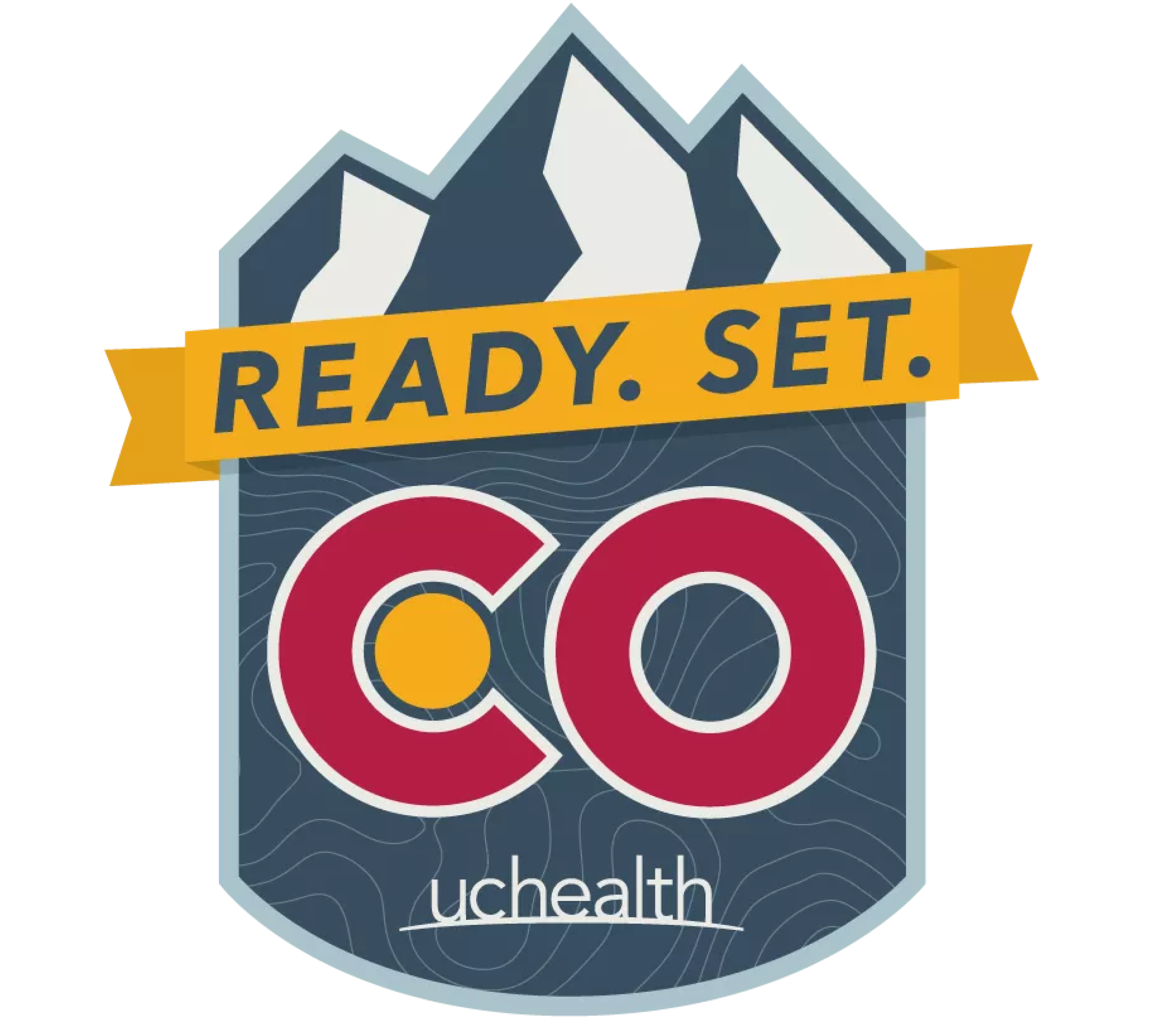
Spotlight: Innovation in Action
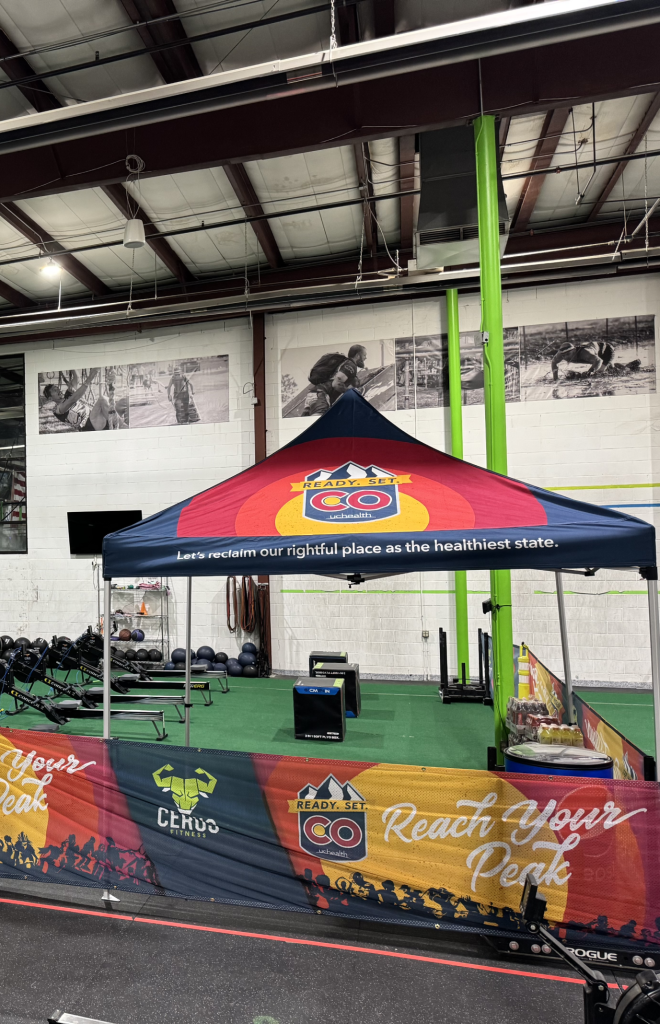


Share your ideas
We’re always looking for new ideas and partnerships to improve the patient experience. Have an innovative concept or know an organization we should partner with? Let us know!


